Social Media Role in Hospitality Industry
VerifiedAdded on 2021/02/19
|27
|5247
|73
AI Summary
Contribute Materials
Your contribution can guide someone’s learning journey. Share your
documents today.

Research Project
Secure Best Marks with AI Grader
Need help grading? Try our AI Grader for instant feedback on your assignments.

Table of Contents
TITLE:.............................................................................................................................................4
Chapter 1: Introduction....................................................................................................................4
Background.................................................................................................................................4
Statement of research problem....................................................................................................4
Research aim...............................................................................................................................4
Objective of research...................................................................................................................4
Research Questions.....................................................................................................................5
Purpose and scope of research ...................................................................................................5
Rationale for selection of topic ..................................................................................................5
Research specifications...............................................................................................................6
Gantt chart...................................................................................................................................6
Work breakdown structure..........................................................................................................6
Research Time Line....................................................................................................................7
LITERATURE REVIEW................................................................................................................8
Positive and negative impact of social media over customer base of Travelodge hotel.............8
Influence of social media over improving customer retention for Travelodge...........................8
TITLE:.............................................................................................................................................4
Chapter 1: Introduction....................................................................................................................4
Background.................................................................................................................................4
Statement of research problem....................................................................................................4
Research aim...............................................................................................................................4
Objective of research...................................................................................................................4
Research Questions.....................................................................................................................5
Purpose and scope of research ...................................................................................................5
Rationale for selection of topic ..................................................................................................5
Research specifications...............................................................................................................6
Gantt chart...................................................................................................................................6
Work breakdown structure..........................................................................................................6
Research Time Line....................................................................................................................7
LITERATURE REVIEW................................................................................................................8
Positive and negative impact of social media over customer base of Travelodge hotel.............8
Influence of social media over improving customer retention for Travelodge...........................8
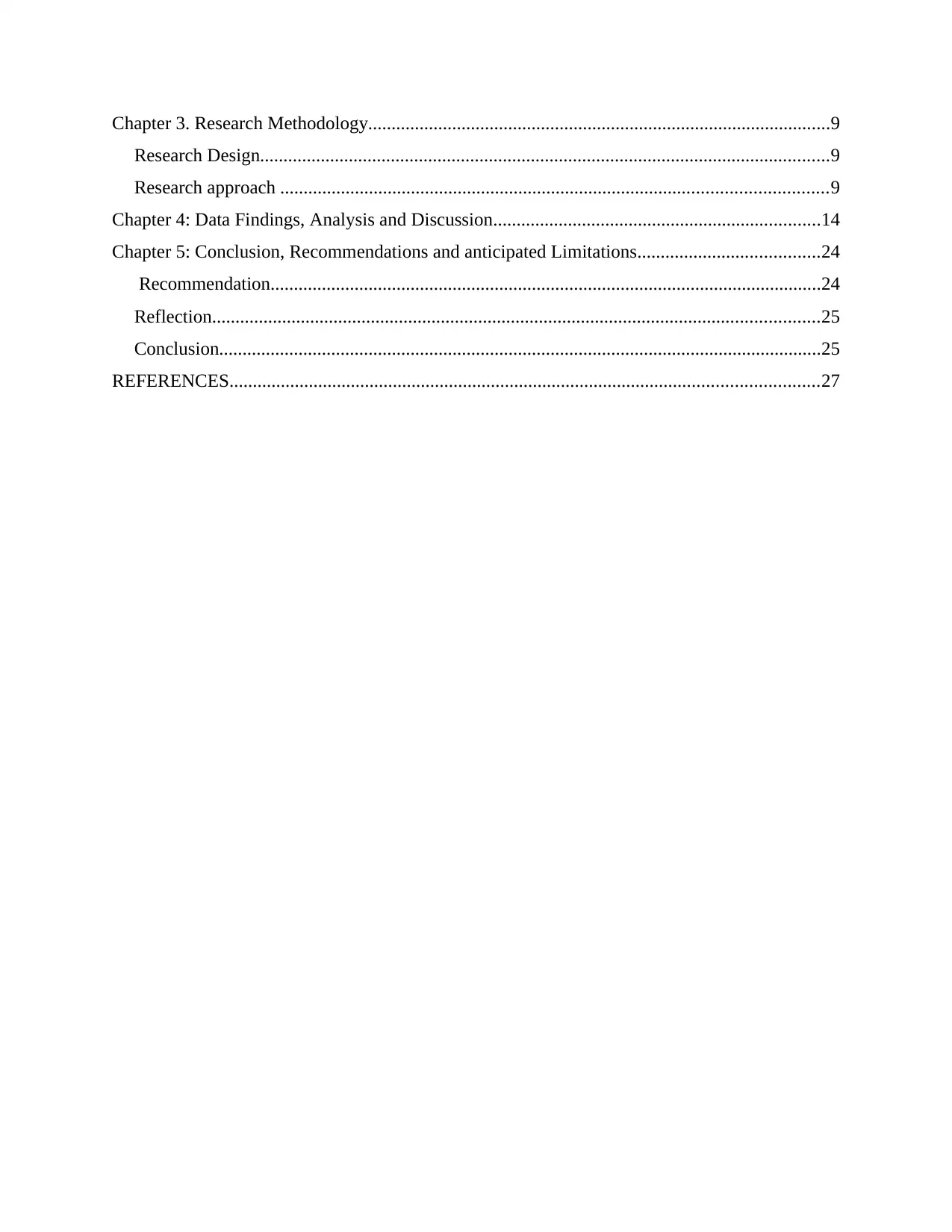
Chapter 3. Research Methodology...................................................................................................9
Research Design..........................................................................................................................9
Research approach .....................................................................................................................9
Chapter 4: Data Findings, Analysis and Discussion......................................................................14
Chapter 5: Conclusion, Recommendations and anticipated Limitations.......................................24
Recommendation......................................................................................................................24
Reflection..................................................................................................................................25
Conclusion.................................................................................................................................25
REFERENCES..............................................................................................................................27
Research Design..........................................................................................................................9
Research approach .....................................................................................................................9
Chapter 4: Data Findings, Analysis and Discussion......................................................................14
Chapter 5: Conclusion, Recommendations and anticipated Limitations.......................................24
Recommendation......................................................................................................................24
Reflection..................................................................................................................................25
Conclusion.................................................................................................................................25
REFERENCES..............................................................................................................................27
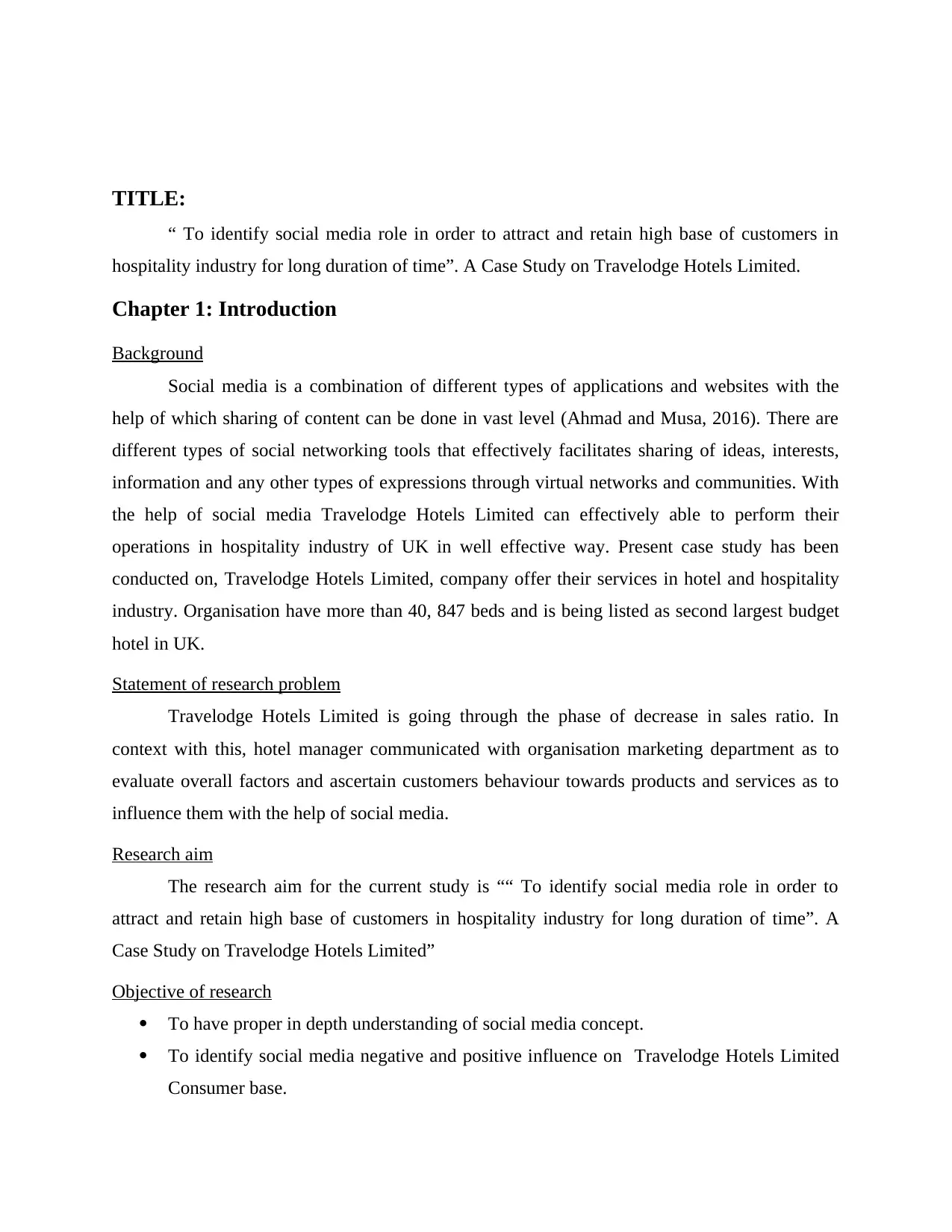
TITLE:
“ To identify social media role in order to attract and retain high base of customers in
hospitality industry for long duration of time”. A Case Study on Travelodge Hotels Limited.
Chapter 1: Introduction
Background
Social media is a combination of different types of applications and websites with the
help of which sharing of content can be done in vast level (Ahmad and Musa, 2016). There are
different types of social networking tools that effectively facilitates sharing of ideas, interests,
information and any other types of expressions through virtual networks and communities. With
the help of social media Travelodge Hotels Limited can effectively able to perform their
operations in hospitality industry of UK in well effective way. Present case study has been
conducted on, Travelodge Hotels Limited, company offer their services in hotel and hospitality
industry. Organisation have more than 40, 847 beds and is being listed as second largest budget
hotel in UK.
Statement of research problem
Travelodge Hotels Limited is going through the phase of decrease in sales ratio. In
context with this, hotel manager communicated with organisation marketing department as to
evaluate overall factors and ascertain customers behaviour towards products and services as to
influence them with the help of social media.
Research aim
The research aim for the current study is ““ To identify social media role in order to
attract and retain high base of customers in hospitality industry for long duration of time”. A
Case Study on Travelodge Hotels Limited”
Objective of research
To have proper in depth understanding of social media concept.
To identify social media negative and positive influence on Travelodge Hotels Limited
Consumer base.
“ To identify social media role in order to attract and retain high base of customers in
hospitality industry for long duration of time”. A Case Study on Travelodge Hotels Limited.
Chapter 1: Introduction
Background
Social media is a combination of different types of applications and websites with the
help of which sharing of content can be done in vast level (Ahmad and Musa, 2016). There are
different types of social networking tools that effectively facilitates sharing of ideas, interests,
information and any other types of expressions through virtual networks and communities. With
the help of social media Travelodge Hotels Limited can effectively able to perform their
operations in hospitality industry of UK in well effective way. Present case study has been
conducted on, Travelodge Hotels Limited, company offer their services in hotel and hospitality
industry. Organisation have more than 40, 847 beds and is being listed as second largest budget
hotel in UK.
Statement of research problem
Travelodge Hotels Limited is going through the phase of decrease in sales ratio. In
context with this, hotel manager communicated with organisation marketing department as to
evaluate overall factors and ascertain customers behaviour towards products and services as to
influence them with the help of social media.
Research aim
The research aim for the current study is ““ To identify social media role in order to
attract and retain high base of customers in hospitality industry for long duration of time”. A
Case Study on Travelodge Hotels Limited”
Objective of research
To have proper in depth understanding of social media concept.
To identify social media negative and positive influence on Travelodge Hotels Limited
Consumer base.
Secure Best Marks with AI Grader
Need help grading? Try our AI Grader for instant feedback on your assignments.
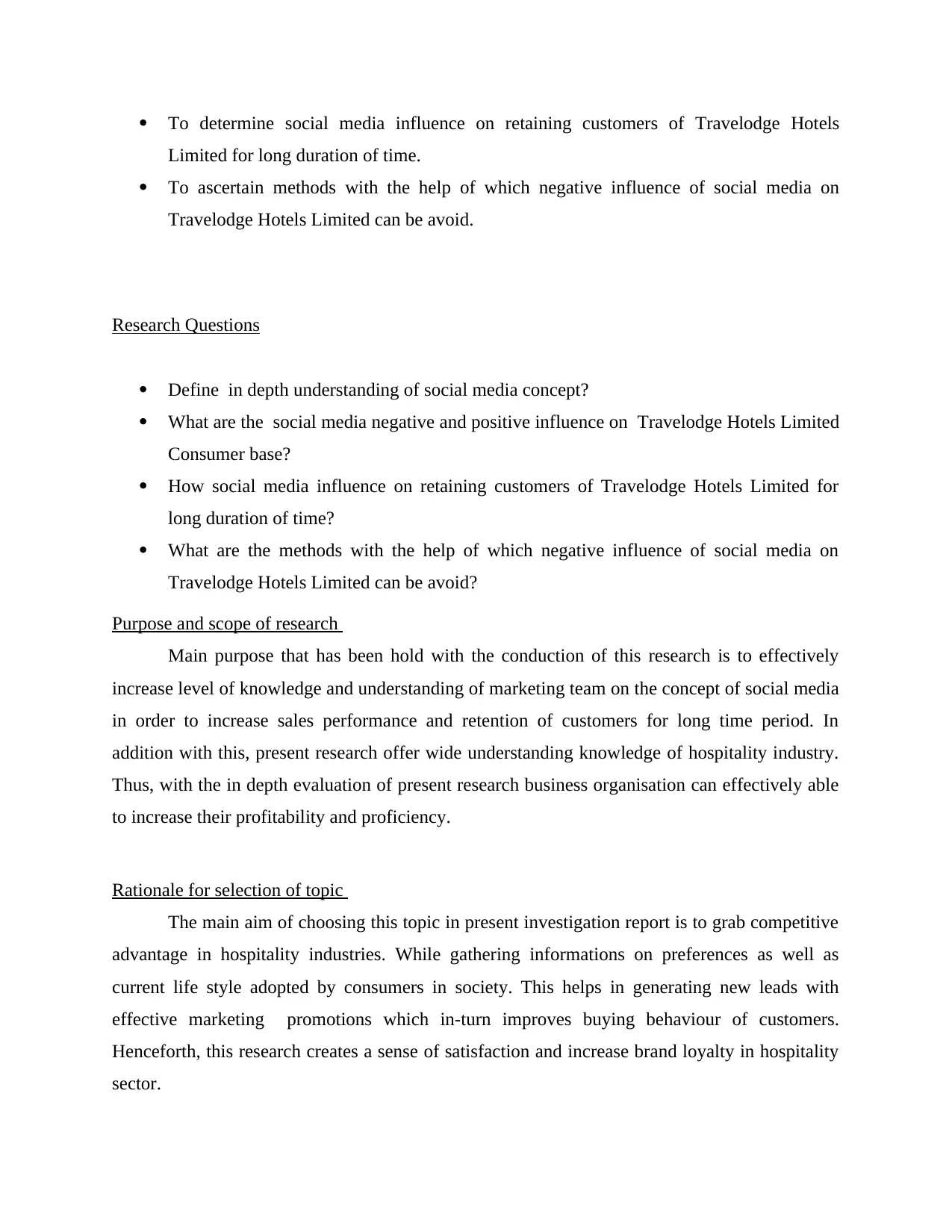
To determine social media influence on retaining customers of Travelodge Hotels
Limited for long duration of time.
To ascertain methods with the help of which negative influence of social media on
Travelodge Hotels Limited can be avoid.
Research Questions
Define in depth understanding of social media concept?
What are the social media negative and positive influence on Travelodge Hotels Limited
Consumer base?
How social media influence on retaining customers of Travelodge Hotels Limited for
long duration of time?
What are the methods with the help of which negative influence of social media on
Travelodge Hotels Limited can be avoid?
Purpose and scope of research
Main purpose that has been hold with the conduction of this research is to effectively
increase level of knowledge and understanding of marketing team on the concept of social media
in order to increase sales performance and retention of customers for long time period. In
addition with this, present research offer wide understanding knowledge of hospitality industry.
Thus, with the in depth evaluation of present research business organisation can effectively able
to increase their profitability and proficiency.
Rationale for selection of topic
The main aim of choosing this topic in present investigation report is to grab competitive
advantage in hospitality industries. While gathering informations on preferences as well as
current life style adopted by consumers in society. This helps in generating new leads with
effective marketing promotions which in-turn improves buying behaviour of customers.
Henceforth, this research creates a sense of satisfaction and increase brand loyalty in hospitality
sector.
Limited for long duration of time.
To ascertain methods with the help of which negative influence of social media on
Travelodge Hotels Limited can be avoid.
Research Questions
Define in depth understanding of social media concept?
What are the social media negative and positive influence on Travelodge Hotels Limited
Consumer base?
How social media influence on retaining customers of Travelodge Hotels Limited for
long duration of time?
What are the methods with the help of which negative influence of social media on
Travelodge Hotels Limited can be avoid?
Purpose and scope of research
Main purpose that has been hold with the conduction of this research is to effectively
increase level of knowledge and understanding of marketing team on the concept of social media
in order to increase sales performance and retention of customers for long time period. In
addition with this, present research offer wide understanding knowledge of hospitality industry.
Thus, with the in depth evaluation of present research business organisation can effectively able
to increase their profitability and proficiency.
Rationale for selection of topic
The main aim of choosing this topic in present investigation report is to grab competitive
advantage in hospitality industries. While gathering informations on preferences as well as
current life style adopted by consumers in society. This helps in generating new leads with
effective marketing promotions which in-turn improves buying behaviour of customers.
Henceforth, this research creates a sense of satisfaction and increase brand loyalty in hospitality
sector.
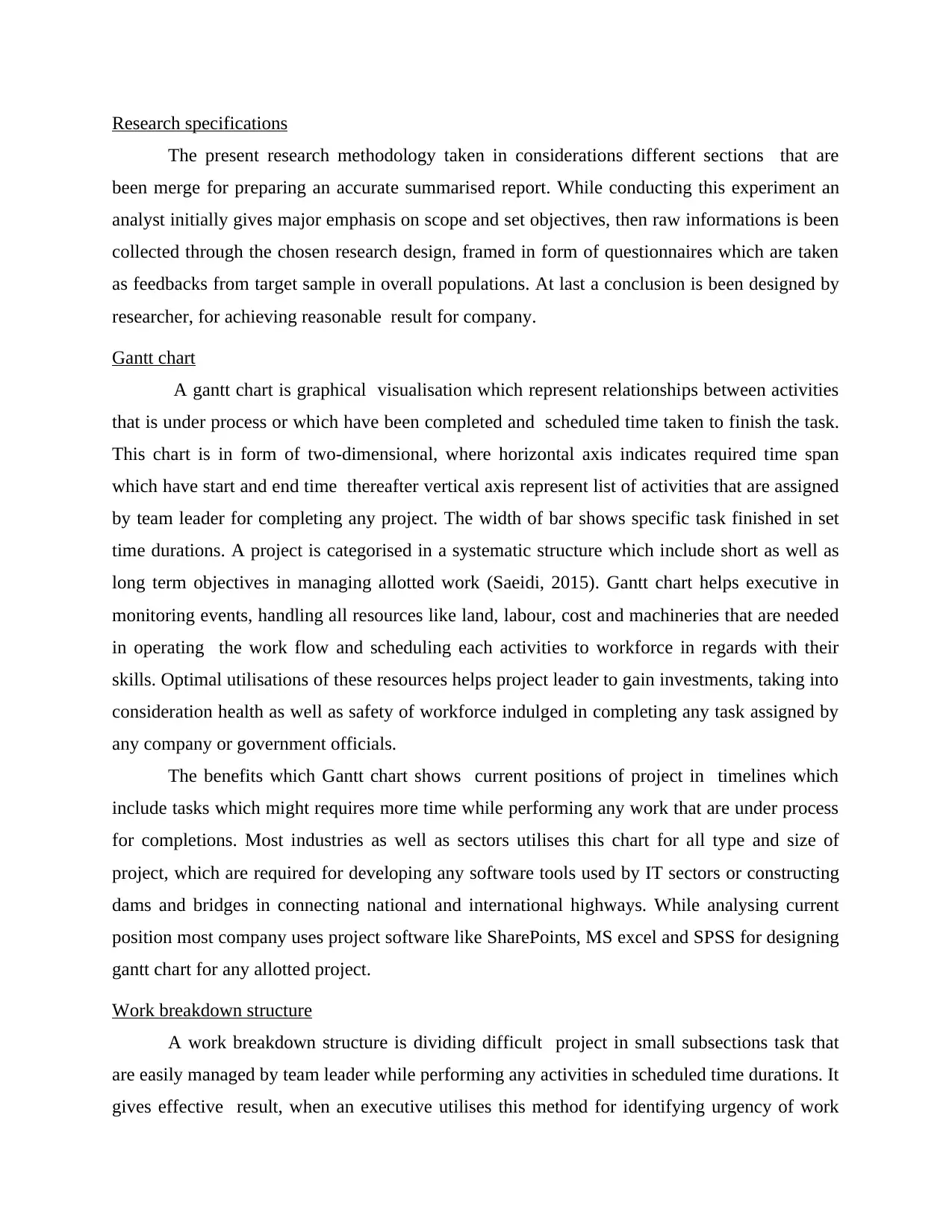
Research specifications
The present research methodology taken in considerations different sections that are
been merge for preparing an accurate summarised report. While conducting this experiment an
analyst initially gives major emphasis on scope and set objectives, then raw informations is been
collected through the chosen research design, framed in form of questionnaires which are taken
as feedbacks from target sample in overall populations. At last a conclusion is been designed by
researcher, for achieving reasonable result for company.
Gantt chart
A gantt chart is graphical visualisation which represent relationships between activities
that is under process or which have been completed and scheduled time taken to finish the task.
This chart is in form of two-dimensional, where horizontal axis indicates required time span
which have start and end time thereafter vertical axis represent list of activities that are assigned
by team leader for completing any project. The width of bar shows specific task finished in set
time durations. A project is categorised in a systematic structure which include short as well as
long term objectives in managing allotted work (Saeidi, 2015). Gantt chart helps executive in
monitoring events, handling all resources like land, labour, cost and machineries that are needed
in operating the work flow and scheduling each activities to workforce in regards with their
skills. Optimal utilisations of these resources helps project leader to gain investments, taking into
consideration health as well as safety of workforce indulged in completing any task assigned by
any company or government officials.
The benefits which Gantt chart shows current positions of project in timelines which
include tasks which might requires more time while performing any work that are under process
for completions. Most industries as well as sectors utilises this chart for all type and size of
project, which are required for developing any software tools used by IT sectors or constructing
dams and bridges in connecting national and international highways. While analysing current
position most company uses project software like SharePoints, MS excel and SPSS for designing
gantt chart for any allotted project.
Work breakdown structure
A work breakdown structure is dividing difficult project in small subsections task that
are easily managed by team leader while performing any activities in scheduled time durations. It
gives effective result, when an executive utilises this method for identifying urgency of work
The present research methodology taken in considerations different sections that are
been merge for preparing an accurate summarised report. While conducting this experiment an
analyst initially gives major emphasis on scope and set objectives, then raw informations is been
collected through the chosen research design, framed in form of questionnaires which are taken
as feedbacks from target sample in overall populations. At last a conclusion is been designed by
researcher, for achieving reasonable result for company.
Gantt chart
A gantt chart is graphical visualisation which represent relationships between activities
that is under process or which have been completed and scheduled time taken to finish the task.
This chart is in form of two-dimensional, where horizontal axis indicates required time span
which have start and end time thereafter vertical axis represent list of activities that are assigned
by team leader for completing any project. The width of bar shows specific task finished in set
time durations. A project is categorised in a systematic structure which include short as well as
long term objectives in managing allotted work (Saeidi, 2015). Gantt chart helps executive in
monitoring events, handling all resources like land, labour, cost and machineries that are needed
in operating the work flow and scheduling each activities to workforce in regards with their
skills. Optimal utilisations of these resources helps project leader to gain investments, taking into
consideration health as well as safety of workforce indulged in completing any task assigned by
any company or government officials.
The benefits which Gantt chart shows current positions of project in timelines which
include tasks which might requires more time while performing any work that are under process
for completions. Most industries as well as sectors utilises this chart for all type and size of
project, which are required for developing any software tools used by IT sectors or constructing
dams and bridges in connecting national and international highways. While analysing current
position most company uses project software like SharePoints, MS excel and SPSS for designing
gantt chart for any allotted project.
Work breakdown structure
A work breakdown structure is dividing difficult project in small subsections task that
are easily managed by team leader while performing any activities in scheduled time durations. It
gives effective result, when an executive utilises this method for identifying urgency of work
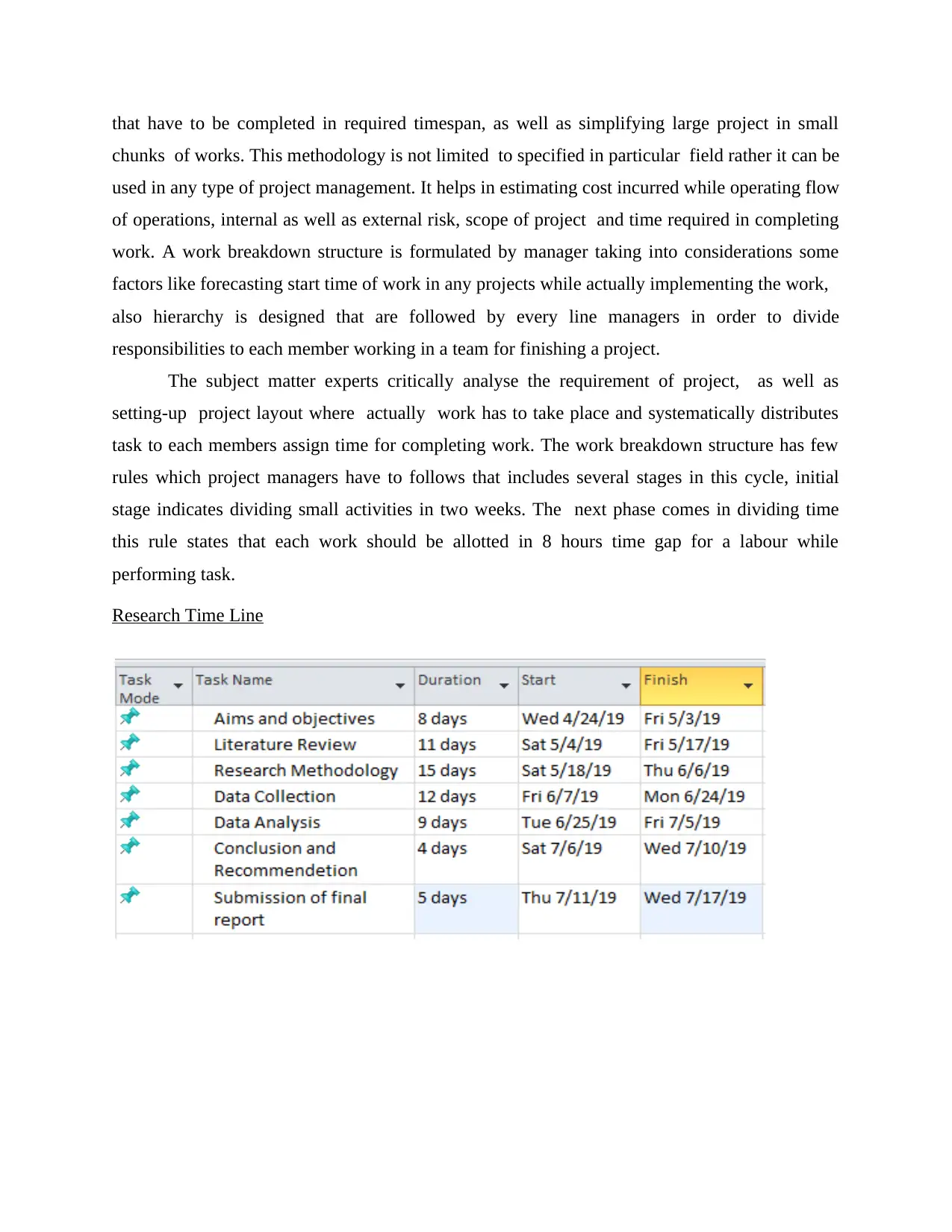
that have to be completed in required timespan, as well as simplifying large project in small
chunks of works. This methodology is not limited to specified in particular field rather it can be
used in any type of project management. It helps in estimating cost incurred while operating flow
of operations, internal as well as external risk, scope of project and time required in completing
work. A work breakdown structure is formulated by manager taking into considerations some
factors like forecasting start time of work in any projects while actually implementing the work,
also hierarchy is designed that are followed by every line managers in order to divide
responsibilities to each member working in a team for finishing a project.
The subject matter experts critically analyse the requirement of project, as well as
setting-up project layout where actually work has to take place and systematically distributes
task to each members assign time for completing work. The work breakdown structure has few
rules which project managers have to follows that includes several stages in this cycle, initial
stage indicates dividing small activities in two weeks. The next phase comes in dividing time
this rule states that each work should be allotted in 8 hours time gap for a labour while
performing task.
Research Time Line
chunks of works. This methodology is not limited to specified in particular field rather it can be
used in any type of project management. It helps in estimating cost incurred while operating flow
of operations, internal as well as external risk, scope of project and time required in completing
work. A work breakdown structure is formulated by manager taking into considerations some
factors like forecasting start time of work in any projects while actually implementing the work,
also hierarchy is designed that are followed by every line managers in order to divide
responsibilities to each member working in a team for finishing a project.
The subject matter experts critically analyse the requirement of project, as well as
setting-up project layout where actually work has to take place and systematically distributes
task to each members assign time for completing work. The work breakdown structure has few
rules which project managers have to follows that includes several stages in this cycle, initial
stage indicates dividing small activities in two weeks. The next phase comes in dividing time
this rule states that each work should be allotted in 8 hours time gap for a labour while
performing task.
Research Time Line
Paraphrase This Document
Need a fresh take? Get an instant paraphrase of this document with our AI Paraphraser

LITERATURE REVIEW
Positive and negative impact of social media over customer base of Travelodge hotel.
According to the view point of........, social media plays a vital role in evolving digital
platform for marketing. It helps in accelerate the awareness about the business and also try to
connect with customer easily. It has been found that communication with customers can portrait
positive as well as negative impact of large customer base. In the case of Travelodge, with the
help of social media company can generate more customers and can develop trust by providing
better services to there regular client. Customer can read the review before booking the hotel on
social media,good rating of hotel given on social media attract more customers. Hotels can also
take feedback from there regular customers which portray the positive impact on the mind of the
customers. In other hand if Travelodge have negative feedback on social media then there can be
chance of developing negative impact on the mind of customer. And all these negative thoughts
can motivate customers not to buy any offering by the hotel. At the end, it can be concluded that
social media is placing negative impact on Travelodge.
Influence of social media over improving customer retention for Travelodge.
As per the view presented by the author...., social media can help in improving the
retention for Travelodge because it helps to know the customers as individual. Nowadays every
person is on social media and every information is accessible through internet. So Travelodge
can provide services according customer taste and preference. For improving customer retention
Positive and negative impact of social media over customer base of Travelodge hotel.
According to the view point of........, social media plays a vital role in evolving digital
platform for marketing. It helps in accelerate the awareness about the business and also try to
connect with customer easily. It has been found that communication with customers can portrait
positive as well as negative impact of large customer base. In the case of Travelodge, with the
help of social media company can generate more customers and can develop trust by providing
better services to there regular client. Customer can read the review before booking the hotel on
social media,good rating of hotel given on social media attract more customers. Hotels can also
take feedback from there regular customers which portray the positive impact on the mind of the
customers. In other hand if Travelodge have negative feedback on social media then there can be
chance of developing negative impact on the mind of customer. And all these negative thoughts
can motivate customers not to buy any offering by the hotel. At the end, it can be concluded that
social media is placing negative impact on Travelodge.
Influence of social media over improving customer retention for Travelodge.
As per the view presented by the author...., social media can help in improving the
retention for Travelodge because it helps to know the customers as individual. Nowadays every
person is on social media and every information is accessible through internet. So Travelodge
can provide services according customer taste and preference. For improving customer retention
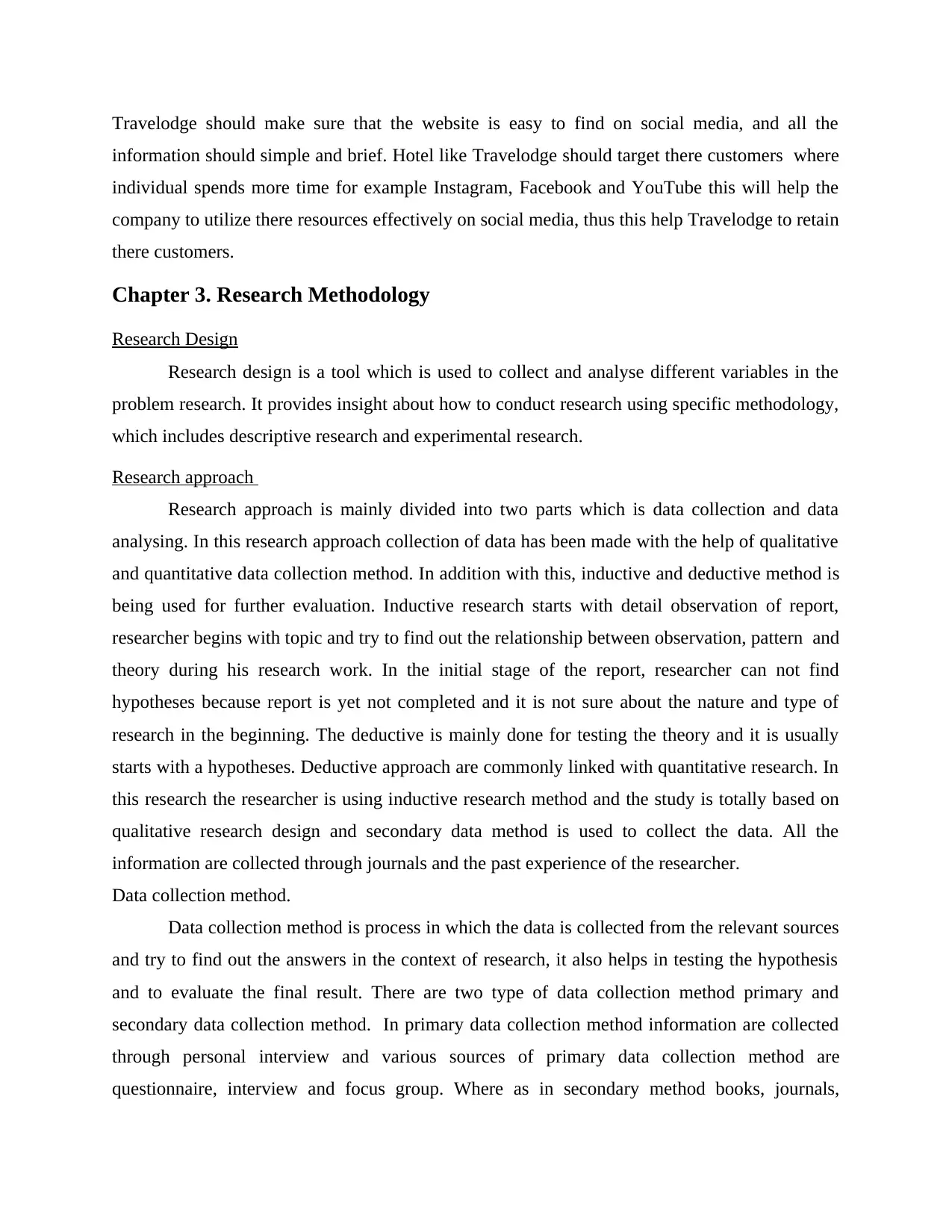
Travelodge should make sure that the website is easy to find on social media, and all the
information should simple and brief. Hotel like Travelodge should target there customers where
individual spends more time for example Instagram, Facebook and YouTube this will help the
company to utilize there resources effectively on social media, thus this help Travelodge to retain
there customers.
Chapter 3. Research Methodology
Research Design
Research design is a tool which is used to collect and analyse different variables in the
problem research. It provides insight about how to conduct research using specific methodology,
which includes descriptive research and experimental research.
Research approach
Research approach is mainly divided into two parts which is data collection and data
analysing. In this research approach collection of data has been made with the help of qualitative
and quantitative data collection method. In addition with this, inductive and deductive method is
being used for further evaluation. Inductive research starts with detail observation of report,
researcher begins with topic and try to find out the relationship between observation, pattern and
theory during his research work. In the initial stage of the report, researcher can not find
hypotheses because report is yet not completed and it is not sure about the nature and type of
research in the beginning. The deductive is mainly done for testing the theory and it is usually
starts with a hypotheses. Deductive approach are commonly linked with quantitative research. In
this research the researcher is using inductive research method and the study is totally based on
qualitative research design and secondary data method is used to collect the data. All the
information are collected through journals and the past experience of the researcher.
Data collection method.
Data collection method is process in which the data is collected from the relevant sources
and try to find out the answers in the context of research, it also helps in testing the hypothesis
and to evaluate the final result. There are two type of data collection method primary and
secondary data collection method. In primary data collection method information are collected
through personal interview and various sources of primary data collection method are
questionnaire, interview and focus group. Where as in secondary method books, journals,
information should simple and brief. Hotel like Travelodge should target there customers where
individual spends more time for example Instagram, Facebook and YouTube this will help the
company to utilize there resources effectively on social media, thus this help Travelodge to retain
there customers.
Chapter 3. Research Methodology
Research Design
Research design is a tool which is used to collect and analyse different variables in the
problem research. It provides insight about how to conduct research using specific methodology,
which includes descriptive research and experimental research.
Research approach
Research approach is mainly divided into two parts which is data collection and data
analysing. In this research approach collection of data has been made with the help of qualitative
and quantitative data collection method. In addition with this, inductive and deductive method is
being used for further evaluation. Inductive research starts with detail observation of report,
researcher begins with topic and try to find out the relationship between observation, pattern and
theory during his research work. In the initial stage of the report, researcher can not find
hypotheses because report is yet not completed and it is not sure about the nature and type of
research in the beginning. The deductive is mainly done for testing the theory and it is usually
starts with a hypotheses. Deductive approach are commonly linked with quantitative research. In
this research the researcher is using inductive research method and the study is totally based on
qualitative research design and secondary data method is used to collect the data. All the
information are collected through journals and the past experience of the researcher.
Data collection method.
Data collection method is process in which the data is collected from the relevant sources
and try to find out the answers in the context of research, it also helps in testing the hypothesis
and to evaluate the final result. There are two type of data collection method primary and
secondary data collection method. In primary data collection method information are collected
through personal interview and various sources of primary data collection method are
questionnaire, interview and focus group. Where as in secondary method books, journals,
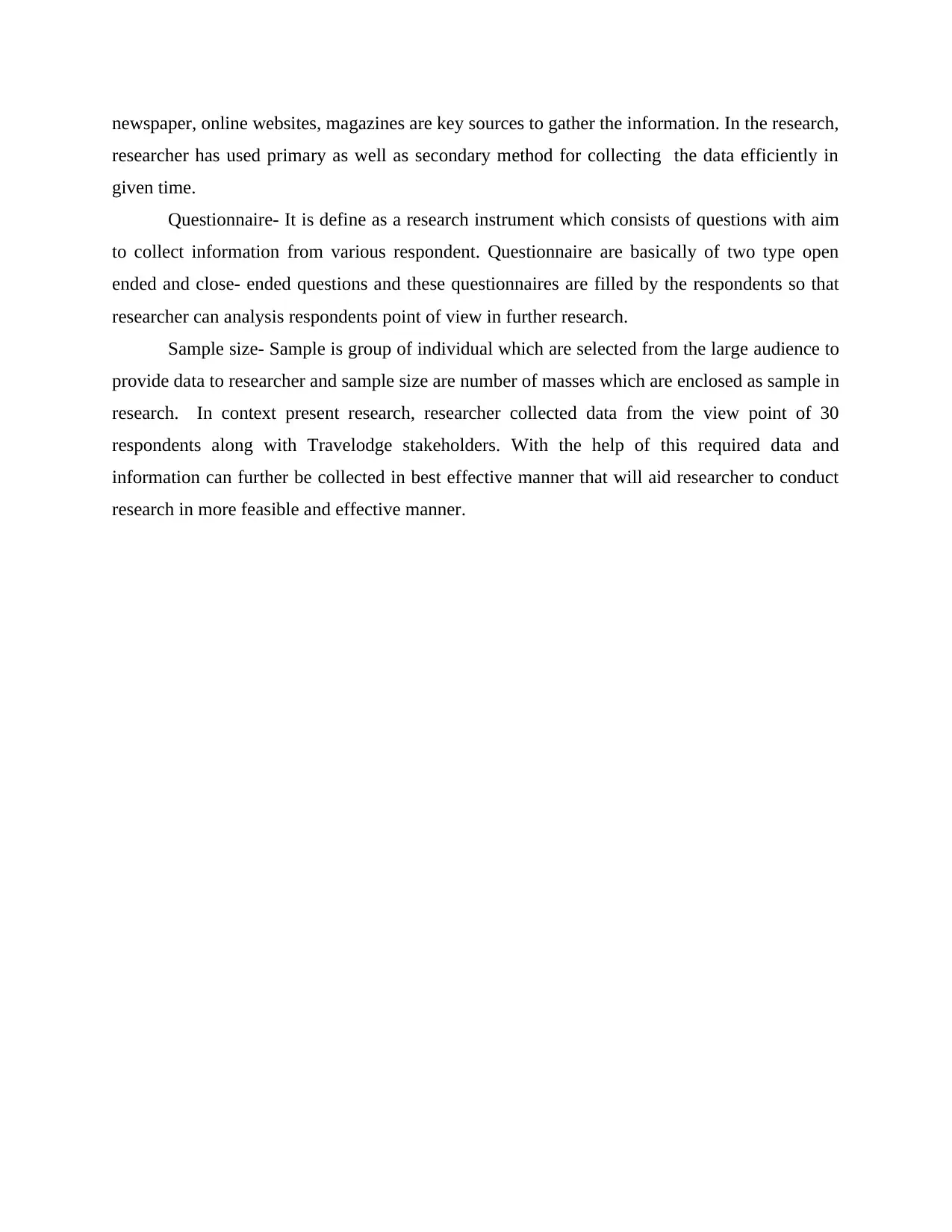
newspaper, online websites, magazines are key sources to gather the information. In the research,
researcher has used primary as well as secondary method for collecting the data efficiently in
given time.
Questionnaire- It is define as a research instrument which consists of questions with aim
to collect information from various respondent. Questionnaire are basically of two type open
ended and close- ended questions and these questionnaires are filled by the respondents so that
researcher can analysis respondents point of view in further research.
Sample size- Sample is group of individual which are selected from the large audience to
provide data to researcher and sample size are number of masses which are enclosed as sample in
research. In context present research, researcher collected data from the view point of 30
respondents along with Travelodge stakeholders. With the help of this required data and
information can further be collected in best effective manner that will aid researcher to conduct
research in more feasible and effective manner.
researcher has used primary as well as secondary method for collecting the data efficiently in
given time.
Questionnaire- It is define as a research instrument which consists of questions with aim
to collect information from various respondent. Questionnaire are basically of two type open
ended and close- ended questions and these questionnaires are filled by the respondents so that
researcher can analysis respondents point of view in further research.
Sample size- Sample is group of individual which are selected from the large audience to
provide data to researcher and sample size are number of masses which are enclosed as sample in
research. In context present research, researcher collected data from the view point of 30
respondents along with Travelodge stakeholders. With the help of this required data and
information can further be collected in best effective manner that will aid researcher to conduct
research in more feasible and effective manner.
Secure Best Marks with AI Grader
Need help grading? Try our AI Grader for instant feedback on your assignments.
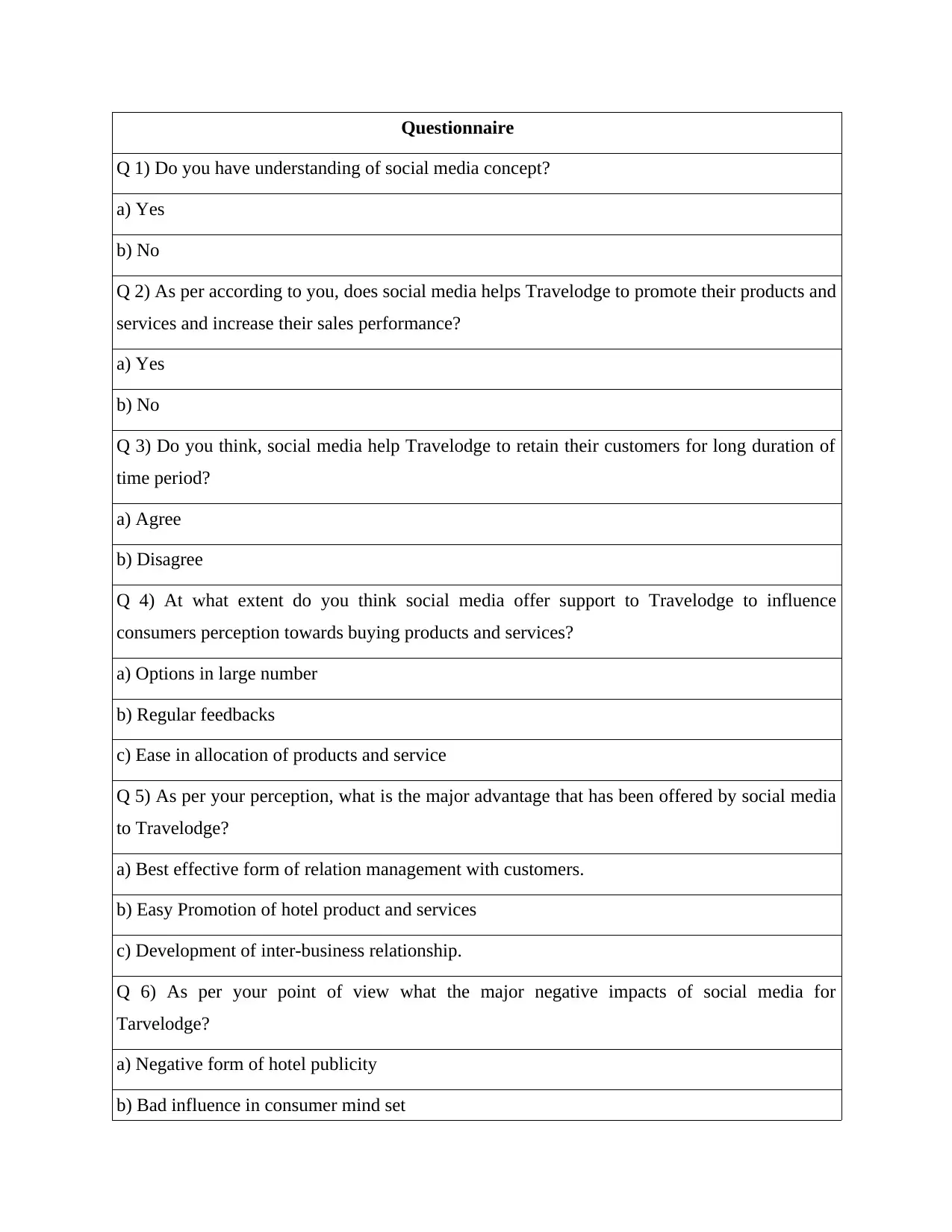
Questionnaire
Q 1) Do you have understanding of social media concept?
a) Yes
b) No
Q 2) As per according to you, does social media helps Travelodge to promote their products and
services and increase their sales performance?
a) Yes
b) No
Q 3) Do you think, social media help Travelodge to retain their customers for long duration of
time period?
a) Agree
b) Disagree
Q 4) At what extent do you think social media offer support to Travelodge to influence
consumers perception towards buying products and services?
a) Options in large number
b) Regular feedbacks
c) Ease in allocation of products and service
Q 5) As per your perception, what is the major advantage that has been offered by social media
to Travelodge?
a) Best effective form of relation management with customers.
b) Easy Promotion of hotel product and services
c) Development of inter-business relationship.
Q 6) As per your point of view what the major negative impacts of social media for
Tarvelodge?
a) Negative form of hotel publicity
b) Bad influence in consumer mind set
Q 1) Do you have understanding of social media concept?
a) Yes
b) No
Q 2) As per according to you, does social media helps Travelodge to promote their products and
services and increase their sales performance?
a) Yes
b) No
Q 3) Do you think, social media help Travelodge to retain their customers for long duration of
time period?
a) Agree
b) Disagree
Q 4) At what extent do you think social media offer support to Travelodge to influence
consumers perception towards buying products and services?
a) Options in large number
b) Regular feedbacks
c) Ease in allocation of products and service
Q 5) As per your perception, what is the major advantage that has been offered by social media
to Travelodge?
a) Best effective form of relation management with customers.
b) Easy Promotion of hotel product and services
c) Development of inter-business relationship.
Q 6) As per your point of view what the major negative impacts of social media for
Tarvelodge?
a) Negative form of hotel publicity
b) Bad influence in consumer mind set

c) Misleading Rumors
Q 7) As per your perception, what can be the measures with the help of which Travelodge can
avoid social media negative impact on their brand image?
a) Release of Press reports
b) Regular Tracking of informations in misleading and negative nature
c) Development of social media abidance strategy
Q 8) Give some recommendation to Travelodge with the help of which they can increase their
customer sustainability.
Questionnaire
Q 1) Do you have understanding of social media concept? Frequency
a) Yes 25
b) No 5
Q 2) As per according to you, does social media helps Travelodge to
promote their products and services and increase their sales
performance?
Frequency
a) Yes 20
b) No 10
Q 3) Do you think, social media help Travelodge to retain their
customers for long duration of time period?
Frequency
a) Agree 25
b) Disagree 5
Q 4) At what extent do you think social media offer support to Frequency
Q 7) As per your perception, what can be the measures with the help of which Travelodge can
avoid social media negative impact on their brand image?
a) Release of Press reports
b) Regular Tracking of informations in misleading and negative nature
c) Development of social media abidance strategy
Q 8) Give some recommendation to Travelodge with the help of which they can increase their
customer sustainability.
Questionnaire
Q 1) Do you have understanding of social media concept? Frequency
a) Yes 25
b) No 5
Q 2) As per according to you, does social media helps Travelodge to
promote their products and services and increase their sales
performance?
Frequency
a) Yes 20
b) No 10
Q 3) Do you think, social media help Travelodge to retain their
customers for long duration of time period?
Frequency
a) Agree 25
b) Disagree 5
Q 4) At what extent do you think social media offer support to Frequency
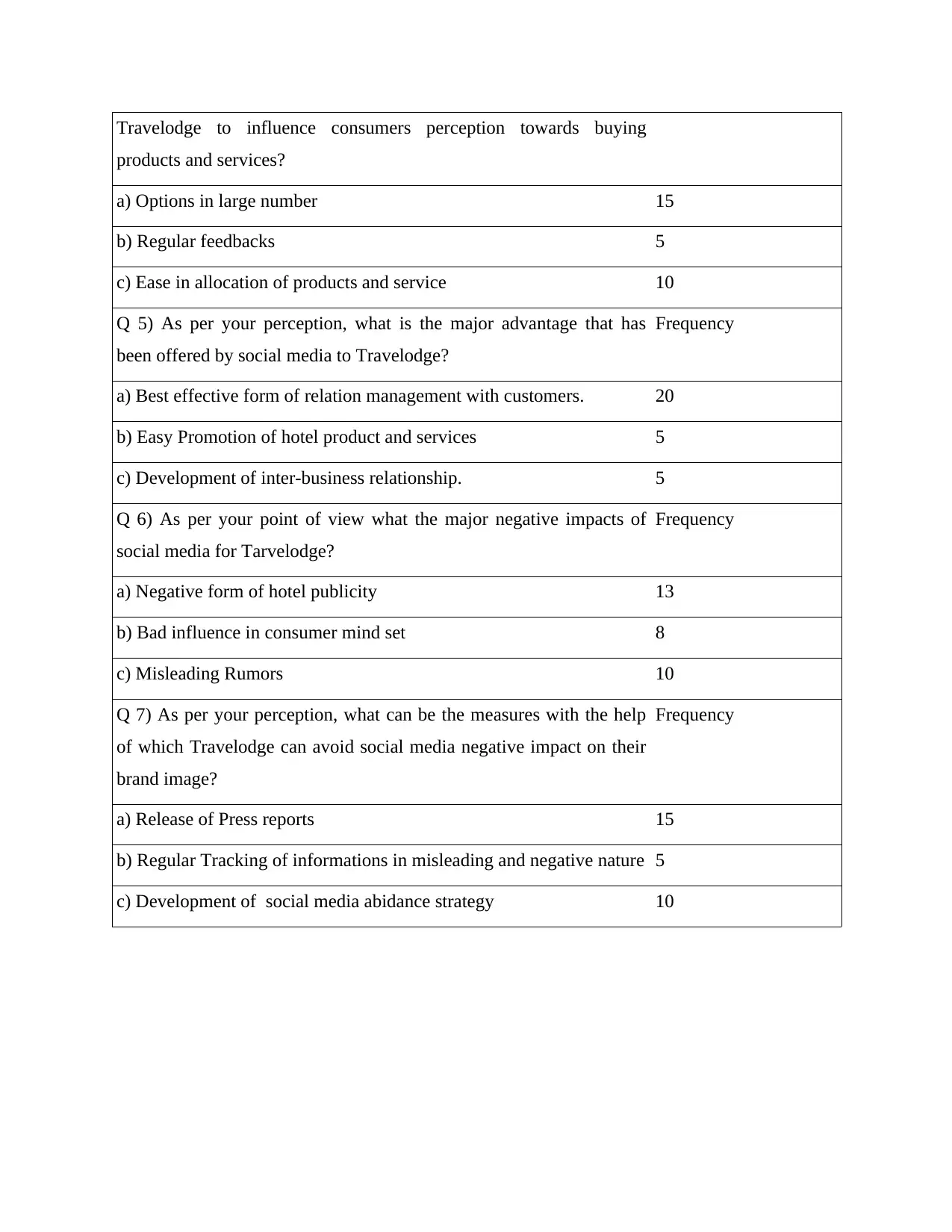
Travelodge to influence consumers perception towards buying
products and services?
a) Options in large number 15
b) Regular feedbacks 5
c) Ease in allocation of products and service 10
Q 5) As per your perception, what is the major advantage that has
been offered by social media to Travelodge?
Frequency
a) Best effective form of relation management with customers. 20
b) Easy Promotion of hotel product and services 5
c) Development of inter-business relationship. 5
Q 6) As per your point of view what the major negative impacts of
social media for Tarvelodge?
Frequency
a) Negative form of hotel publicity 13
b) Bad influence in consumer mind set 8
c) Misleading Rumors 10
Q 7) As per your perception, what can be the measures with the help
of which Travelodge can avoid social media negative impact on their
brand image?
Frequency
a) Release of Press reports 15
b) Regular Tracking of informations in misleading and negative nature 5
c) Development of social media abidance strategy 10
products and services?
a) Options in large number 15
b) Regular feedbacks 5
c) Ease in allocation of products and service 10
Q 5) As per your perception, what is the major advantage that has
been offered by social media to Travelodge?
Frequency
a) Best effective form of relation management with customers. 20
b) Easy Promotion of hotel product and services 5
c) Development of inter-business relationship. 5
Q 6) As per your point of view what the major negative impacts of
social media for Tarvelodge?
Frequency
a) Negative form of hotel publicity 13
b) Bad influence in consumer mind set 8
c) Misleading Rumors 10
Q 7) As per your perception, what can be the measures with the help
of which Travelodge can avoid social media negative impact on their
brand image?
Frequency
a) Release of Press reports 15
b) Regular Tracking of informations in misleading and negative nature 5
c) Development of social media abidance strategy 10
Paraphrase This Document
Need a fresh take? Get an instant paraphrase of this document with our AI Paraphraser
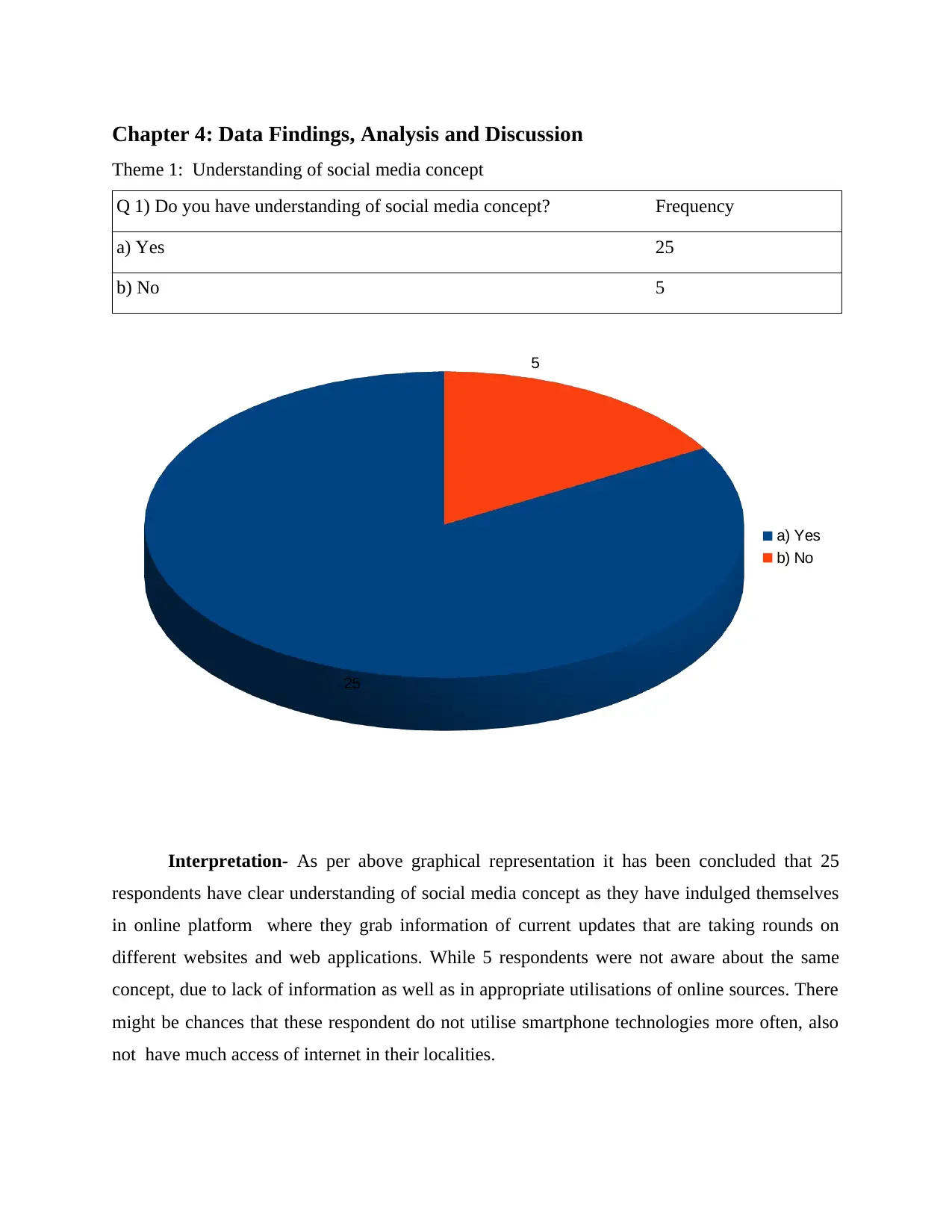
Chapter 4: Data Findings, Analysis and Discussion
Theme 1: Understanding of social media concept
Q 1) Do you have understanding of social media concept? Frequency
a) Yes 25
b) No 5
Interpretation- As per above graphical representation it has been concluded that 25
respondents have clear understanding of social media concept as they have indulged themselves
in online platform where they grab information of current updates that are taking rounds on
different websites and web applications. While 5 respondents were not aware about the same
concept, due to lack of information as well as in appropriate utilisations of online sources. There
might be chances that these respondent do not utilise smartphone technologies more often, also
not have much access of internet in their localities.
25
5
a) Yes
b) No
Theme 1: Understanding of social media concept
Q 1) Do you have understanding of social media concept? Frequency
a) Yes 25
b) No 5
Interpretation- As per above graphical representation it has been concluded that 25
respondents have clear understanding of social media concept as they have indulged themselves
in online platform where they grab information of current updates that are taking rounds on
different websites and web applications. While 5 respondents were not aware about the same
concept, due to lack of information as well as in appropriate utilisations of online sources. There
might be chances that these respondent do not utilise smartphone technologies more often, also
not have much access of internet in their localities.
25
5
a) Yes
b) No
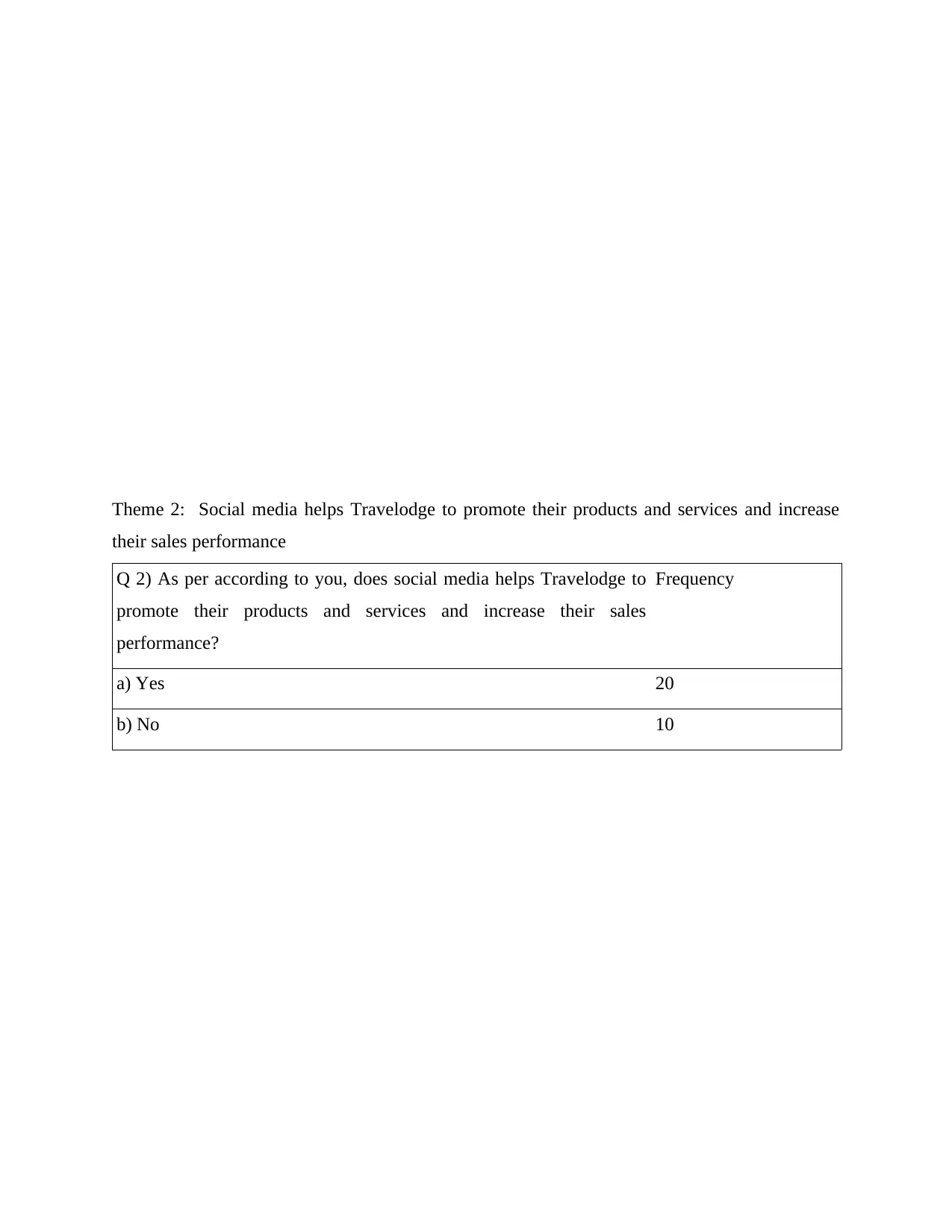
Theme 2: Social media helps Travelodge to promote their products and services and increase
their sales performance
Q 2) As per according to you, does social media helps Travelodge to
promote their products and services and increase their sales
performance?
Frequency
a) Yes 20
b) No 10
their sales performance
Q 2) As per according to you, does social media helps Travelodge to
promote their products and services and increase their sales
performance?
Frequency
a) Yes 20
b) No 10
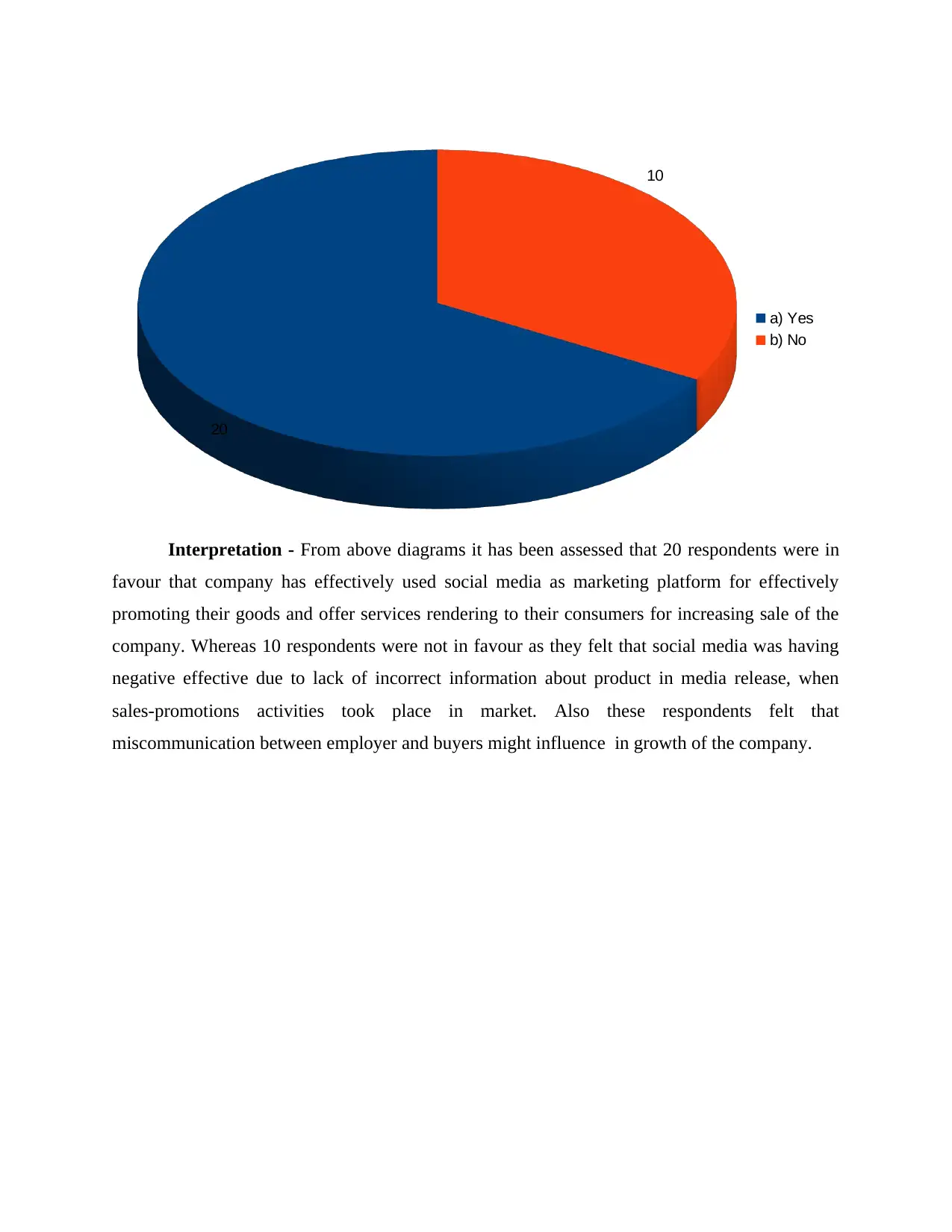
Interpretation - From above diagrams it has been assessed that 20 respondents were in
favour that company has effectively used social media as marketing platform for effectively
promoting their goods and offer services rendering to their consumers for increasing sale of the
company. Whereas 10 respondents were not in favour as they felt that social media was having
negative effective due to lack of incorrect information about product in media release, when
sales-promotions activities took place in market. Also these respondents felt that
miscommunication between employer and buyers might influence in growth of the company.
20
10
a) Yes
b) No
favour that company has effectively used social media as marketing platform for effectively
promoting their goods and offer services rendering to their consumers for increasing sale of the
company. Whereas 10 respondents were not in favour as they felt that social media was having
negative effective due to lack of incorrect information about product in media release, when
sales-promotions activities took place in market. Also these respondents felt that
miscommunication between employer and buyers might influence in growth of the company.
20
10
a) Yes
b) No
Secure Best Marks with AI Grader
Need help grading? Try our AI Grader for instant feedback on your assignments.
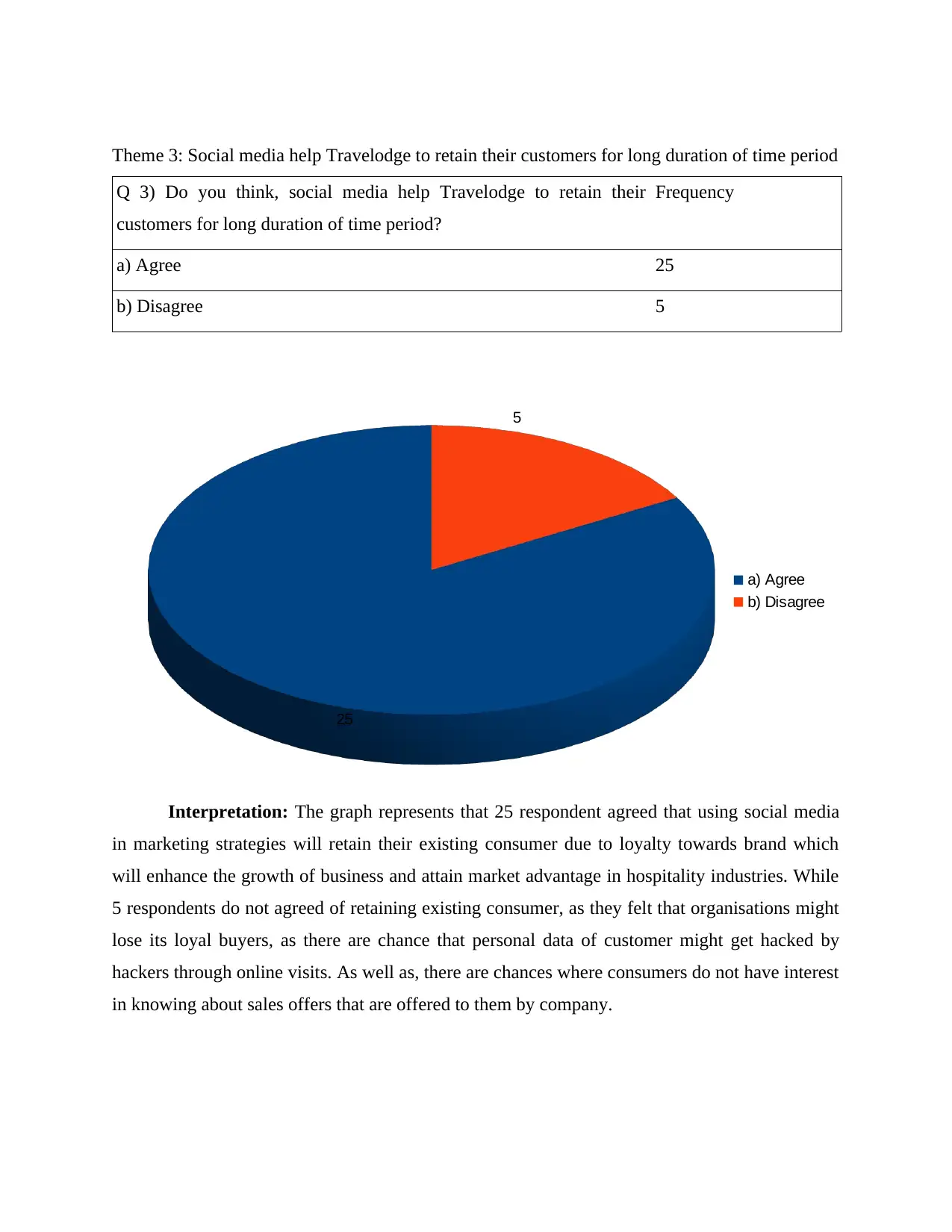
Theme 3: Social media help Travelodge to retain their customers for long duration of time period
Q 3) Do you think, social media help Travelodge to retain their
customers for long duration of time period?
Frequency
a) Agree 25
b) Disagree 5
Interpretation: The graph represents that 25 respondent agreed that using social media
in marketing strategies will retain their existing consumer due to loyalty towards brand which
will enhance the growth of business and attain market advantage in hospitality industries. While
5 respondents do not agreed of retaining existing consumer, as they felt that organisations might
lose its loyal buyers, as there are chance that personal data of customer might get hacked by
hackers through online visits. As well as, there are chances where consumers do not have interest
in knowing about sales offers that are offered to them by company.
25
5
a) Agree
b) Disagree
Q 3) Do you think, social media help Travelodge to retain their
customers for long duration of time period?
Frequency
a) Agree 25
b) Disagree 5
Interpretation: The graph represents that 25 respondent agreed that using social media
in marketing strategies will retain their existing consumer due to loyalty towards brand which
will enhance the growth of business and attain market advantage in hospitality industries. While
5 respondents do not agreed of retaining existing consumer, as they felt that organisations might
lose its loyal buyers, as there are chance that personal data of customer might get hacked by
hackers through online visits. As well as, there are chances where consumers do not have interest
in knowing about sales offers that are offered to them by company.
25
5
a) Agree
b) Disagree
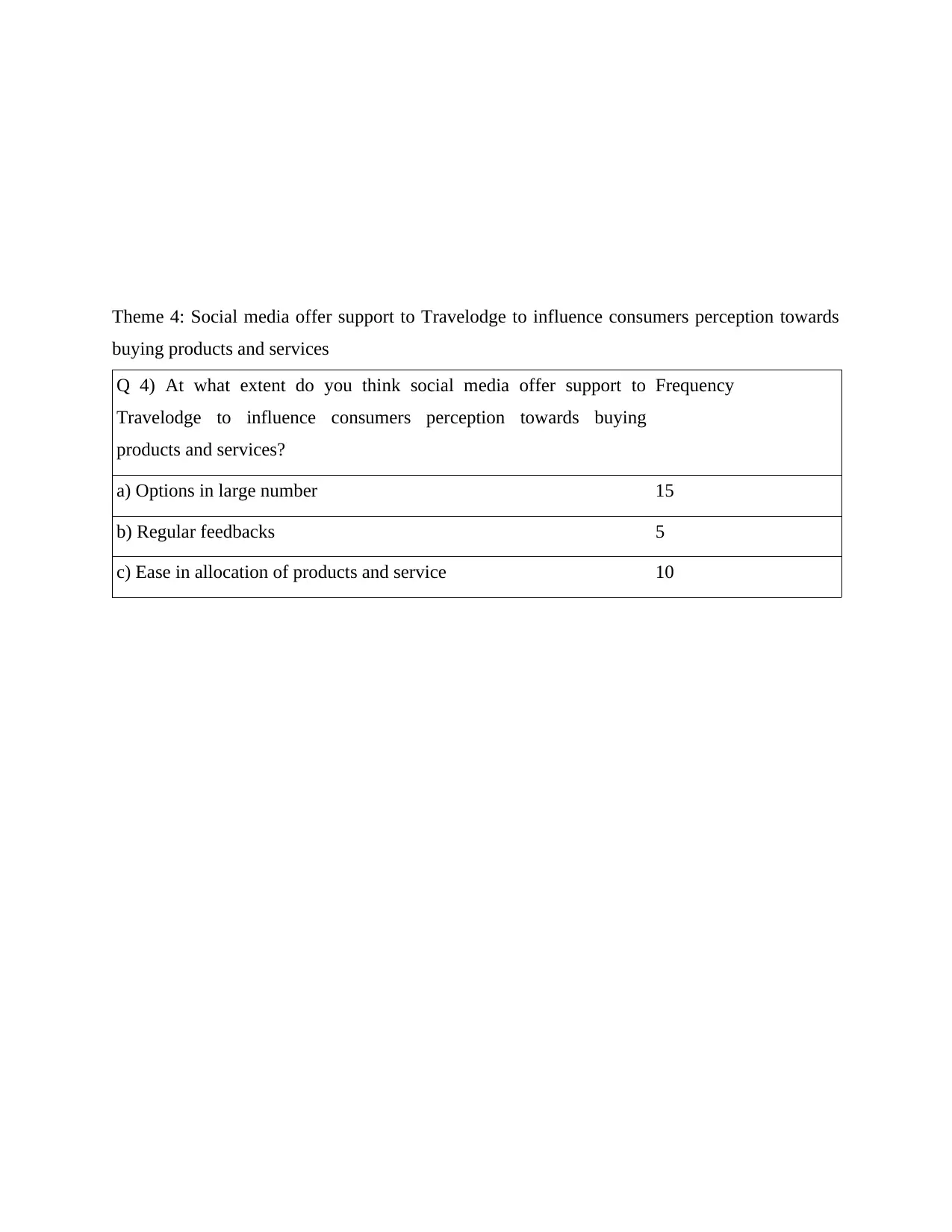
Theme 4: Social media offer support to Travelodge to influence consumers perception towards
buying products and services
Q 4) At what extent do you think social media offer support to
Travelodge to influence consumers perception towards buying
products and services?
Frequency
a) Options in large number 15
b) Regular feedbacks 5
c) Ease in allocation of products and service 10
buying products and services
Q 4) At what extent do you think social media offer support to
Travelodge to influence consumers perception towards buying
products and services?
Frequency
a) Options in large number 15
b) Regular feedbacks 5
c) Ease in allocation of products and service 10

Interpretations: The diagrammatic representation explains that 15 respondent said that
due various option on social media platform many doors are open for company in promoting
their products and service offering which are effective for consumers. While 5 respondent felt
that taking feedback from existing buyers will helps in improving the quality of hotels goods that
are scaled up by department or organisation. Thereafter 5 respondent said that there should be
proper allocation of goods in different places taking in consideration the satisfaction level of
buyers who will be consuming goods and offers that are rendered by company, while planning
for expansion of business across globe.
15
5
10
a) Options in large number
b) Regular feedbacks
c) Ease in allocation of
products and service
due various option on social media platform many doors are open for company in promoting
their products and service offering which are effective for consumers. While 5 respondent felt
that taking feedback from existing buyers will helps in improving the quality of hotels goods that
are scaled up by department or organisation. Thereafter 5 respondent said that there should be
proper allocation of goods in different places taking in consideration the satisfaction level of
buyers who will be consuming goods and offers that are rendered by company, while planning
for expansion of business across globe.
15
5
10
a) Options in large number
b) Regular feedbacks
c) Ease in allocation of
products and service
Paraphrase This Document
Need a fresh take? Get an instant paraphrase of this document with our AI Paraphraser
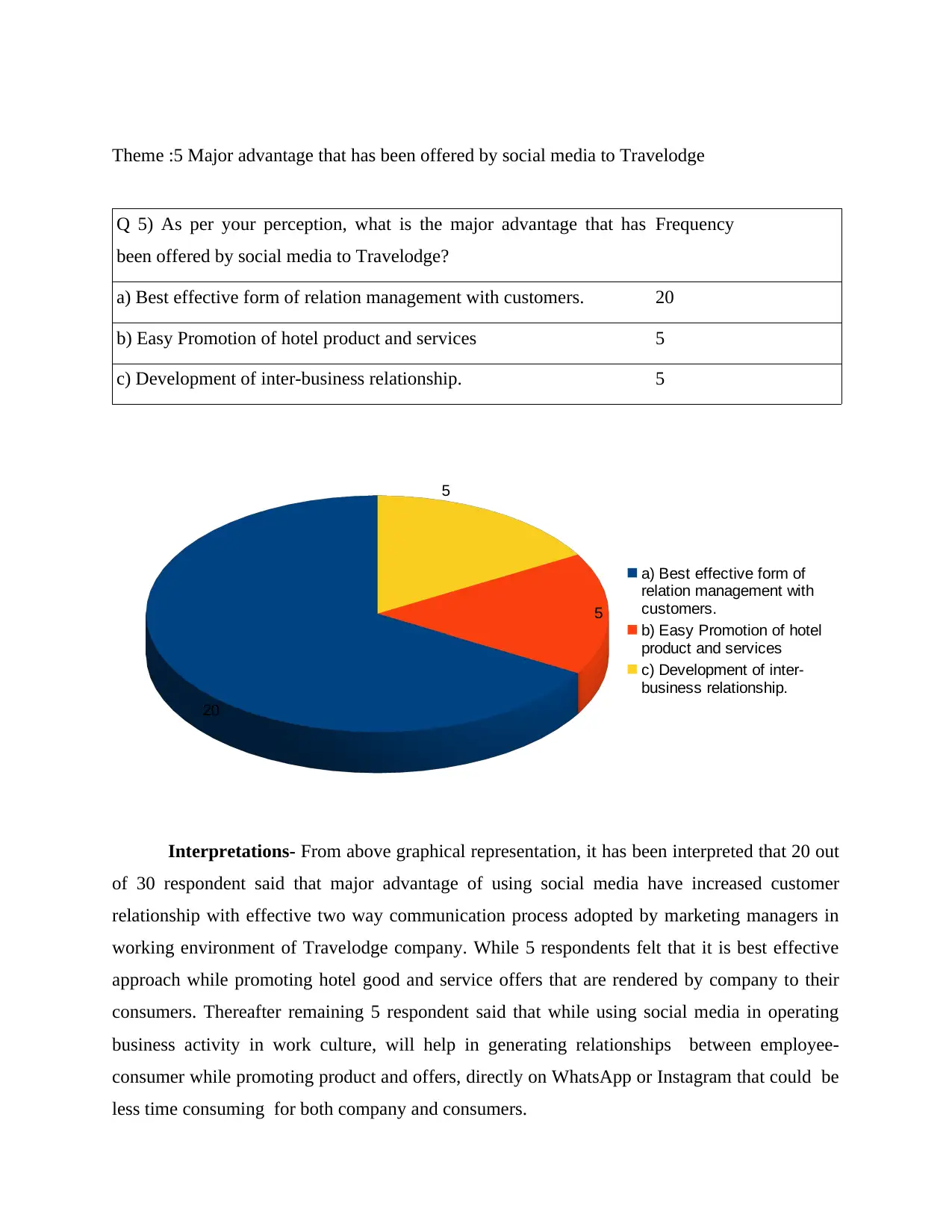
Theme :5 Major advantage that has been offered by social media to Travelodge
Q 5) As per your perception, what is the major advantage that has
been offered by social media to Travelodge?
Frequency
a) Best effective form of relation management with customers. 20
b) Easy Promotion of hotel product and services 5
c) Development of inter-business relationship. 5
Interpretations- From above graphical representation, it has been interpreted that 20 out
of 30 respondent said that major advantage of using social media have increased customer
relationship with effective two way communication process adopted by marketing managers in
working environment of Travelodge company. While 5 respondents felt that it is best effective
approach while promoting hotel good and service offers that are rendered by company to their
consumers. Thereafter remaining 5 respondent said that while using social media in operating
business activity in work culture, will help in generating relationships between employee-
consumer while promoting product and offers, directly on WhatsApp or Instagram that could be
less time consuming for both company and consumers.
20
5
5
a) Best effective form of
relation management with
customers.
b) Easy Promotion of hotel
product and services
c) Development of inter-
business relationship.
Q 5) As per your perception, what is the major advantage that has
been offered by social media to Travelodge?
Frequency
a) Best effective form of relation management with customers. 20
b) Easy Promotion of hotel product and services 5
c) Development of inter-business relationship. 5
Interpretations- From above graphical representation, it has been interpreted that 20 out
of 30 respondent said that major advantage of using social media have increased customer
relationship with effective two way communication process adopted by marketing managers in
working environment of Travelodge company. While 5 respondents felt that it is best effective
approach while promoting hotel good and service offers that are rendered by company to their
consumers. Thereafter remaining 5 respondent said that while using social media in operating
business activity in work culture, will help in generating relationships between employee-
consumer while promoting product and offers, directly on WhatsApp or Instagram that could be
less time consuming for both company and consumers.
20
5
5
a) Best effective form of
relation management with
customers.
b) Easy Promotion of hotel
product and services
c) Development of inter-
business relationship.
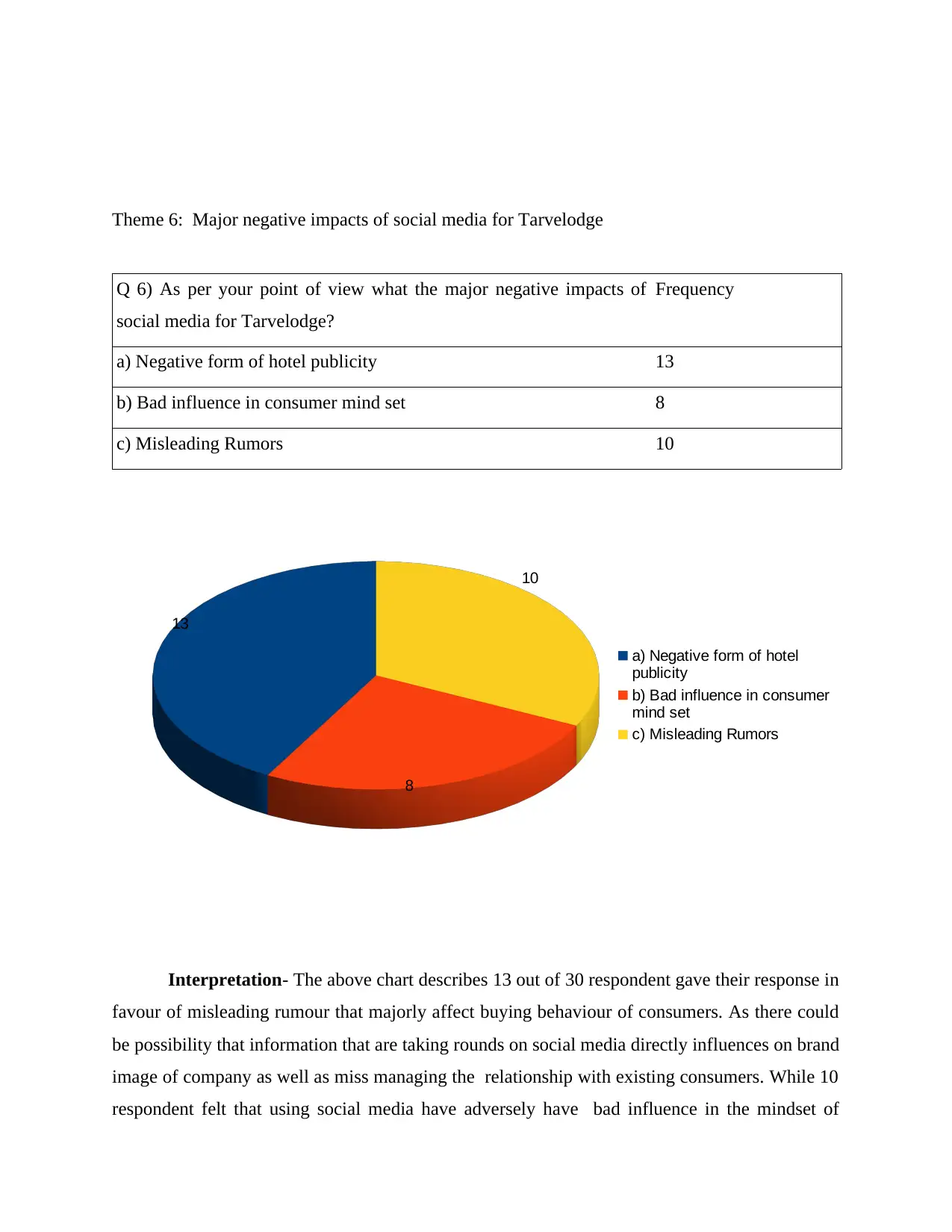
Theme 6: Major negative impacts of social media for Tarvelodge
Q 6) As per your point of view what the major negative impacts of
social media for Tarvelodge?
Frequency
a) Negative form of hotel publicity 13
b) Bad influence in consumer mind set 8
c) Misleading Rumors 10
Interpretation- The above chart describes 13 out of 30 respondent gave their response in
favour of misleading rumour that majorly affect buying behaviour of consumers. As there could
be possibility that information that are taking rounds on social media directly influences on brand
image of company as well as miss managing the relationship with existing consumers. While 10
respondent felt that using social media have adversely have bad influence in the mindset of
13
8
10
a) Negative form of hotel
publicity
b) Bad influence in consumer
mind set
c) Misleading Rumors
Q 6) As per your point of view what the major negative impacts of
social media for Tarvelodge?
Frequency
a) Negative form of hotel publicity 13
b) Bad influence in consumer mind set 8
c) Misleading Rumors 10
Interpretation- The above chart describes 13 out of 30 respondent gave their response in
favour of misleading rumour that majorly affect buying behaviour of consumers. As there could
be possibility that information that are taking rounds on social media directly influences on brand
image of company as well as miss managing the relationship with existing consumers. While 10
respondent felt that using social media have adversely have bad influence in the mindset of
13
8
10
a) Negative form of hotel
publicity
b) Bad influence in consumer
mind set
c) Misleading Rumors
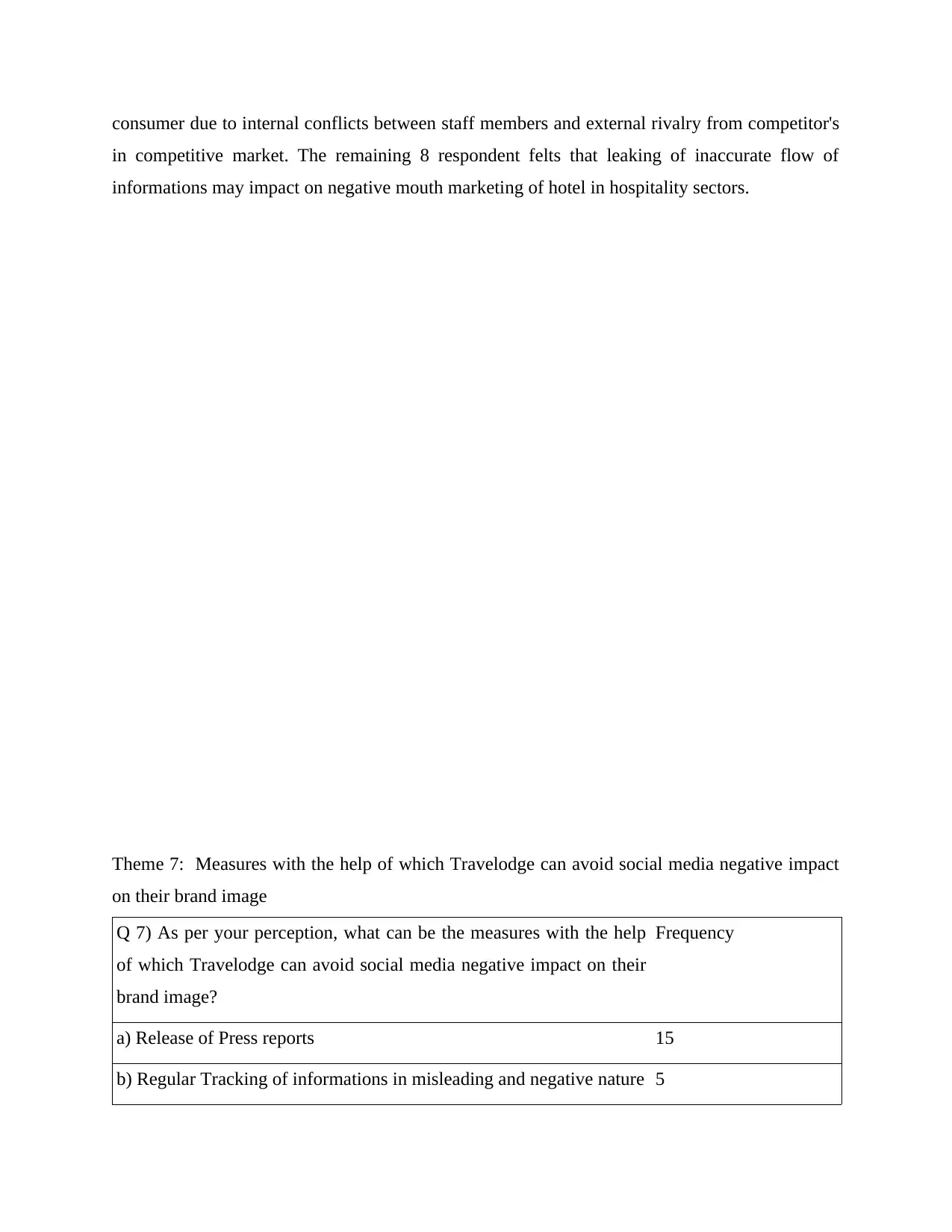
consumer due to internal conflicts between staff members and external rivalry from competitor's
in competitive market. The remaining 8 respondent felts that leaking of inaccurate flow of
informations may impact on negative mouth marketing of hotel in hospitality sectors.
Theme 7: Measures with the help of which Travelodge can avoid social media negative impact
on their brand image
Q 7) As per your perception, what can be the measures with the help
of which Travelodge can avoid social media negative impact on their
brand image?
Frequency
a) Release of Press reports 15
b) Regular Tracking of informations in misleading and negative nature 5
in competitive market. The remaining 8 respondent felts that leaking of inaccurate flow of
informations may impact on negative mouth marketing of hotel in hospitality sectors.
Theme 7: Measures with the help of which Travelodge can avoid social media negative impact
on their brand image
Q 7) As per your perception, what can be the measures with the help
of which Travelodge can avoid social media negative impact on their
brand image?
Frequency
a) Release of Press reports 15
b) Regular Tracking of informations in misleading and negative nature 5
Secure Best Marks with AI Grader
Need help grading? Try our AI Grader for instant feedback on your assignments.
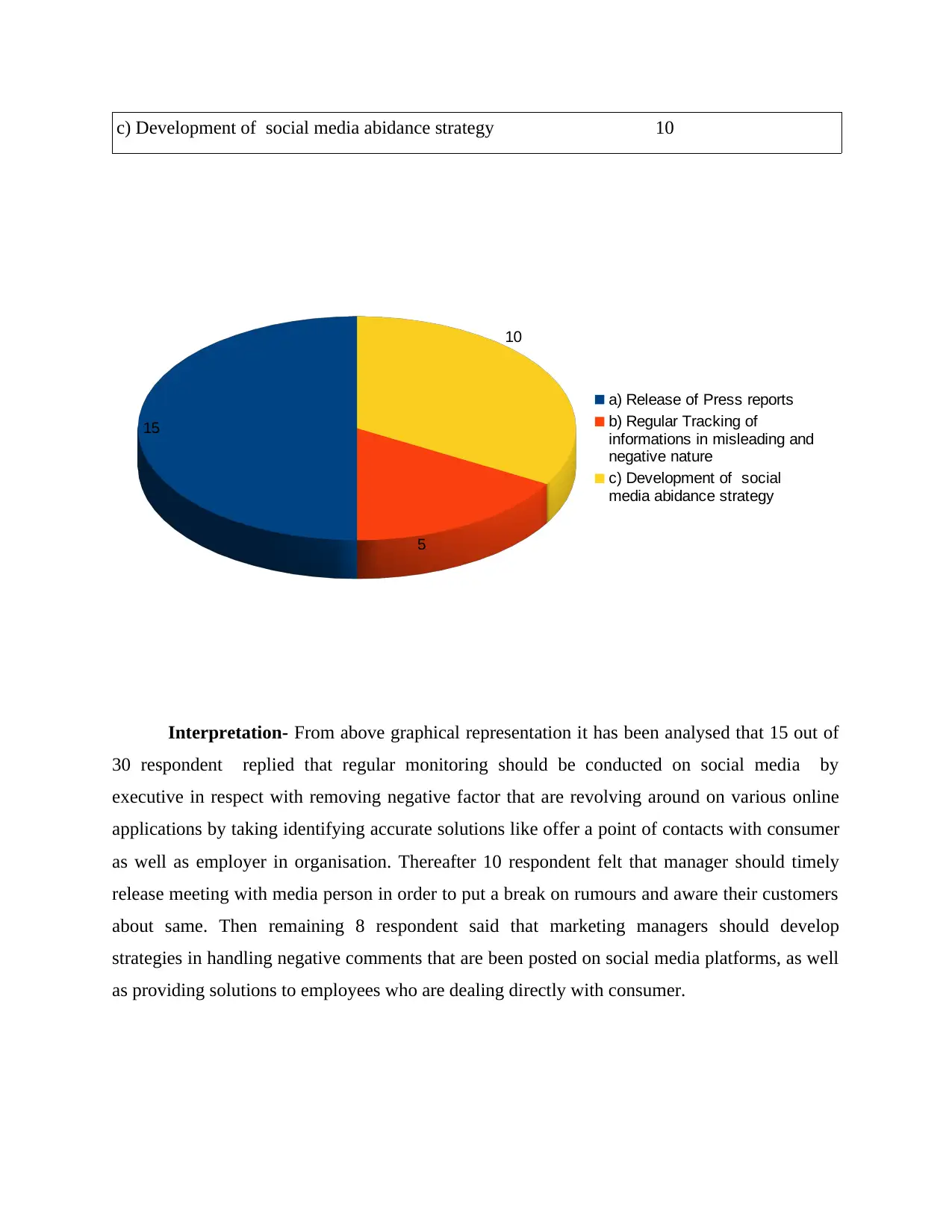
c) Development of social media abidance strategy 10
Interpretation- From above graphical representation it has been analysed that 15 out of
30 respondent replied that regular monitoring should be conducted on social media by
executive in respect with removing negative factor that are revolving around on various online
applications by taking identifying accurate solutions like offer a point of contacts with consumer
as well as employer in organisation. Thereafter 10 respondent felt that manager should timely
release meeting with media person in order to put a break on rumours and aware their customers
about same. Then remaining 8 respondent said that marketing managers should develop
strategies in handling negative comments that are been posted on social media platforms, as well
as providing solutions to employees who are dealing directly with consumer.
15
5
10
a) Release of Press reports
b) Regular Tracking of
informations in misleading and
negative nature
c) Development of social
media abidance strategy
Interpretation- From above graphical representation it has been analysed that 15 out of
30 respondent replied that regular monitoring should be conducted on social media by
executive in respect with removing negative factor that are revolving around on various online
applications by taking identifying accurate solutions like offer a point of contacts with consumer
as well as employer in organisation. Thereafter 10 respondent felt that manager should timely
release meeting with media person in order to put a break on rumours and aware their customers
about same. Then remaining 8 respondent said that marketing managers should develop
strategies in handling negative comments that are been posted on social media platforms, as well
as providing solutions to employees who are dealing directly with consumer.
15
5
10
a) Release of Press reports
b) Regular Tracking of
informations in misleading and
negative nature
c) Development of social
media abidance strategy
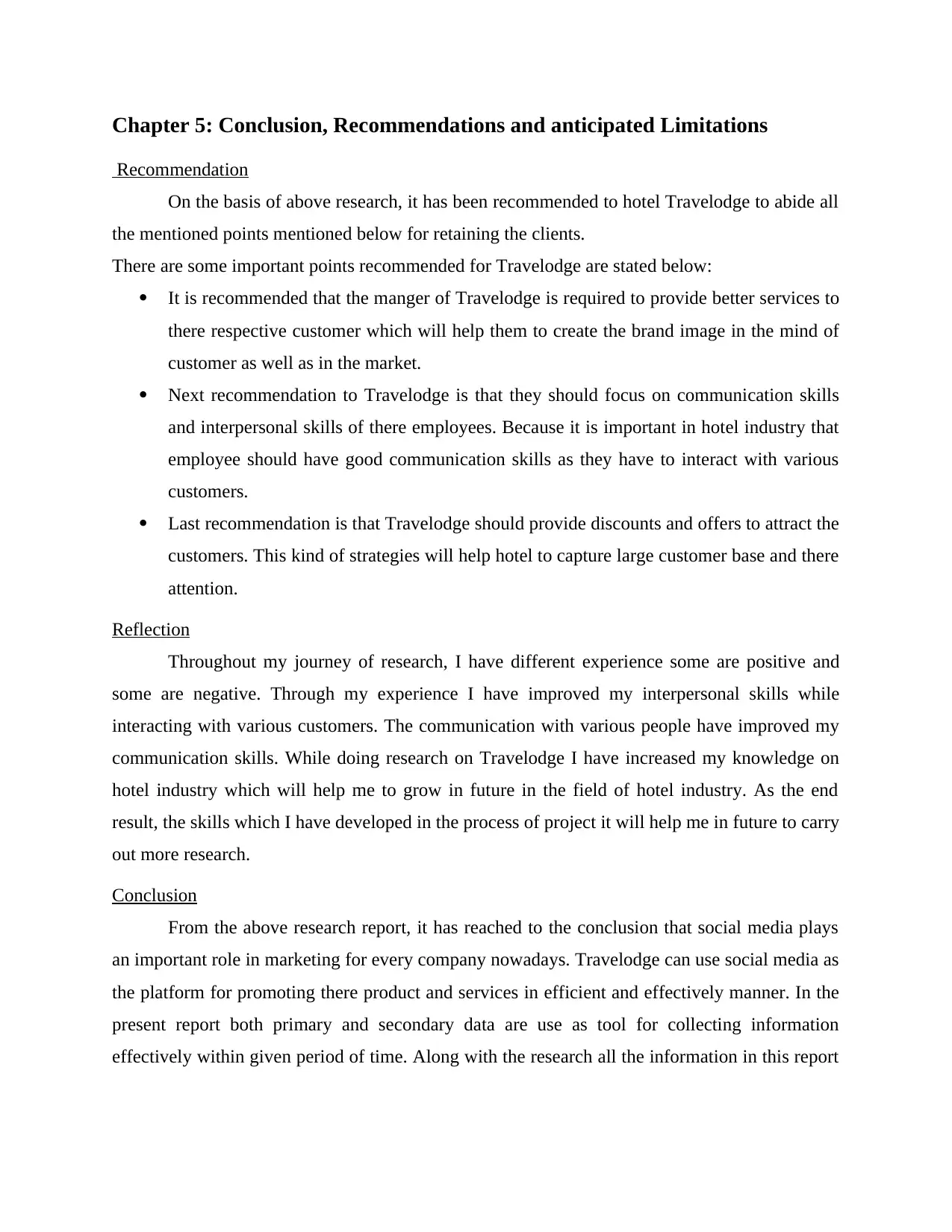
Chapter 5: Conclusion, Recommendations and anticipated Limitations
Recommendation
On the basis of above research, it has been recommended to hotel Travelodge to abide all
the mentioned points mentioned below for retaining the clients.
There are some important points recommended for Travelodge are stated below:
It is recommended that the manger of Travelodge is required to provide better services to
there respective customer which will help them to create the brand image in the mind of
customer as well as in the market.
Next recommendation to Travelodge is that they should focus on communication skills
and interpersonal skills of there employees. Because it is important in hotel industry that
employee should have good communication skills as they have to interact with various
customers.
Last recommendation is that Travelodge should provide discounts and offers to attract the
customers. This kind of strategies will help hotel to capture large customer base and there
attention.
Reflection
Throughout my journey of research, I have different experience some are positive and
some are negative. Through my experience I have improved my interpersonal skills while
interacting with various customers. The communication with various people have improved my
communication skills. While doing research on Travelodge I have increased my knowledge on
hotel industry which will help me to grow in future in the field of hotel industry. As the end
result, the skills which I have developed in the process of project it will help me in future to carry
out more research.
Conclusion
From the above research report, it has reached to the conclusion that social media plays
an important role in marketing for every company nowadays. Travelodge can use social media as
the platform for promoting there product and services in efficient and effectively manner. In the
present report both primary and secondary data are use as tool for collecting information
effectively within given period of time. Along with the research all the information in this report
Recommendation
On the basis of above research, it has been recommended to hotel Travelodge to abide all
the mentioned points mentioned below for retaining the clients.
There are some important points recommended for Travelodge are stated below:
It is recommended that the manger of Travelodge is required to provide better services to
there respective customer which will help them to create the brand image in the mind of
customer as well as in the market.
Next recommendation to Travelodge is that they should focus on communication skills
and interpersonal skills of there employees. Because it is important in hotel industry that
employee should have good communication skills as they have to interact with various
customers.
Last recommendation is that Travelodge should provide discounts and offers to attract the
customers. This kind of strategies will help hotel to capture large customer base and there
attention.
Reflection
Throughout my journey of research, I have different experience some are positive and
some are negative. Through my experience I have improved my interpersonal skills while
interacting with various customers. The communication with various people have improved my
communication skills. While doing research on Travelodge I have increased my knowledge on
hotel industry which will help me to grow in future in the field of hotel industry. As the end
result, the skills which I have developed in the process of project it will help me in future to carry
out more research.
Conclusion
From the above research report, it has reached to the conclusion that social media plays
an important role in marketing for every company nowadays. Travelodge can use social media as
the platform for promoting there product and services in efficient and effectively manner. In the
present report both primary and secondary data are use as tool for collecting information
effectively within given period of time. Along with the research all the information in this report
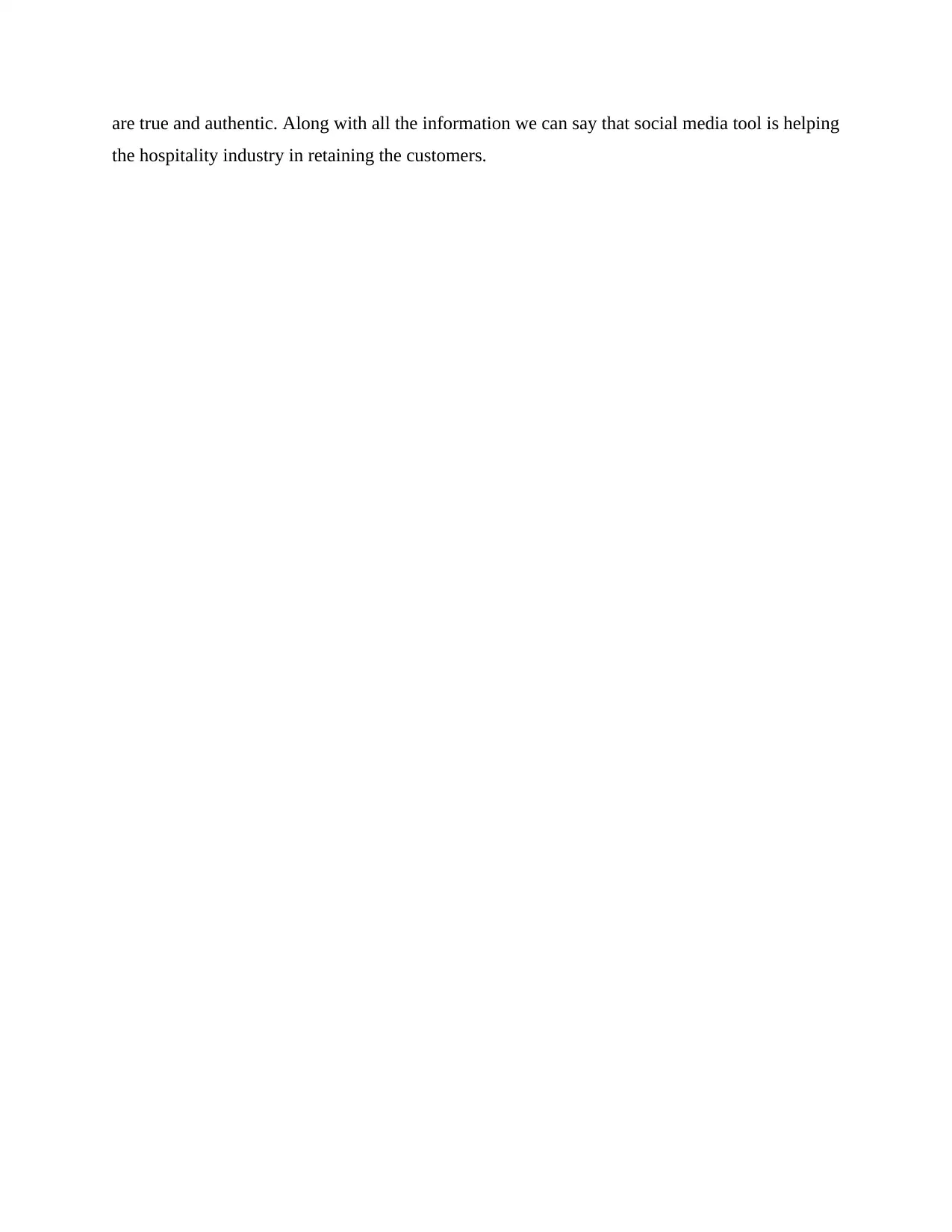
are true and authentic. Along with all the information we can say that social media tool is helping
the hospitality industry in retaining the customers.
the hospitality industry in retaining the customers.
Paraphrase This Document
Need a fresh take? Get an instant paraphrase of this document with our AI Paraphraser
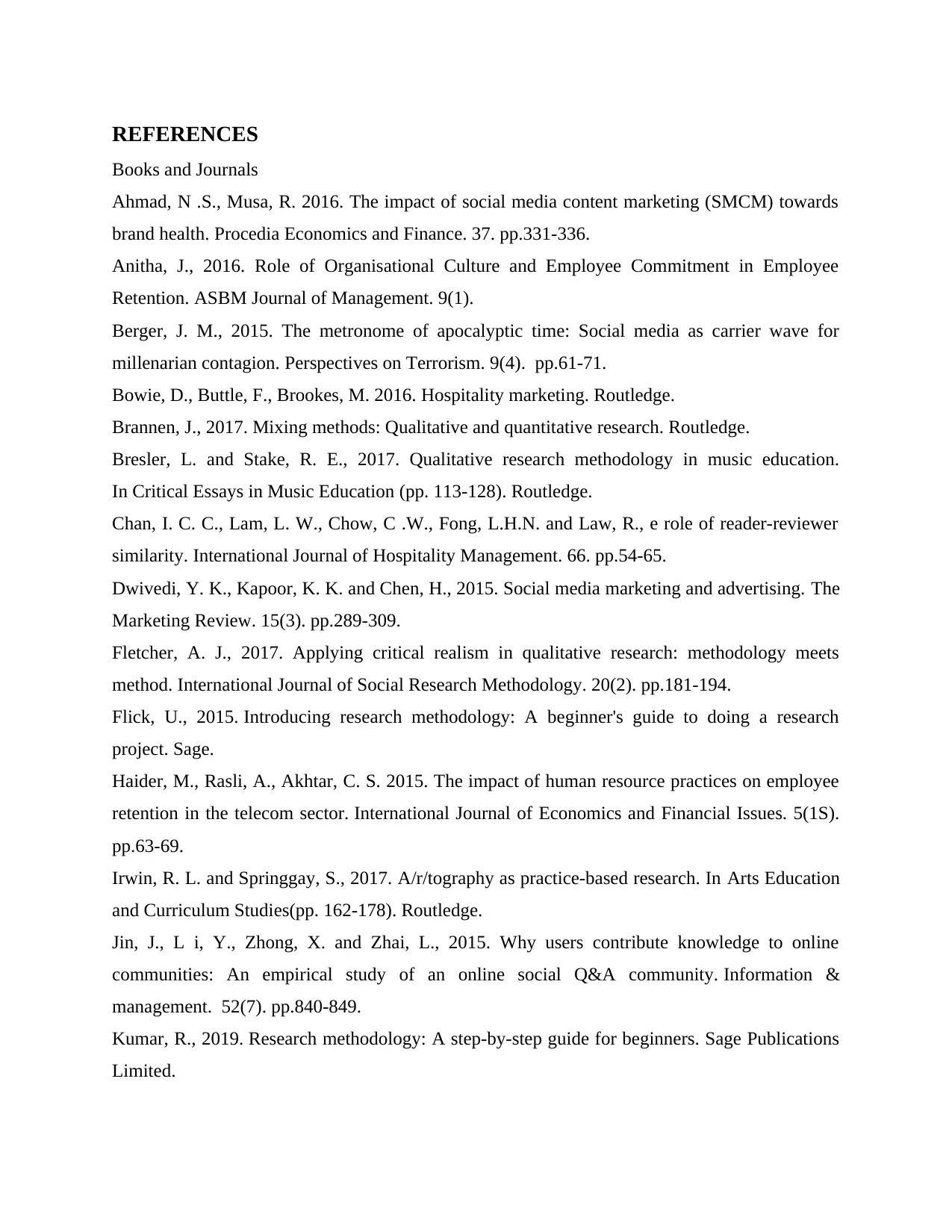
REFERENCES
Books and Journals
Ahmad, N .S., Musa, R. 2016. The impact of social media content marketing (SMCM) towards
brand health. Procedia Economics and Finance. 37. pp.331-336.
Anitha, J., 2016. Role of Organisational Culture and Employee Commitment in Employee
Retention. ASBM Journal of Management. 9(1).
Berger, J. M., 2015. The metronome of apocalyptic time: Social media as carrier wave for
millenarian contagion. Perspectives on Terrorism. 9(4). pp.61-71.
Bowie, D., Buttle, F., Brookes, M. 2016. Hospitality marketing. Routledge.
Brannen, J., 2017. Mixing methods: Qualitative and quantitative research. Routledge.
Bresler, L. and Stake, R. E., 2017. Qualitative research methodology in music education.
In Critical Essays in Music Education (pp. 113-128). Routledge.
Chan, I. C. C., Lam, L. W., Chow, C .W., Fong, L.H.N. and Law, R., e role of reader-reviewer
similarity. International Journal of Hospitality Management. 66. pp.54-65.
Dwivedi, Y. K., Kapoor, K. K. and Chen, H., 2015. Social media marketing and advertising. The
Marketing Review. 15(3). pp.289-309.
Fletcher, A. J., 2017. Applying critical realism in qualitative research: methodology meets
method. International Journal of Social Research Methodology. 20(2). pp.181-194.
Flick, U., 2015. Introducing research methodology: A beginner's guide to doing a research
project. Sage.
Haider, M., Rasli, A., Akhtar, C. S. 2015. The impact of human resource practices on employee
retention in the telecom sector. International Journal of Economics and Financial Issues. 5(1S).
pp.63-69.
Irwin, R. L. and Springgay, S., 2017. A/r/tography as practice-based research. In Arts Education
and Curriculum Studies(pp. 162-178). Routledge.
Jin, J., L i, Y., Zhong, X. and Zhai, L., 2015. Why users contribute knowledge to online
communities: An empirical study of an online social Q&A community. Information &
management. 52(7). pp.840-849.
Kumar, R., 2019. Research methodology: A step-by-step guide for beginners. Sage Publications
Limited.
Books and Journals
Ahmad, N .S., Musa, R. 2016. The impact of social media content marketing (SMCM) towards
brand health. Procedia Economics and Finance. 37. pp.331-336.
Anitha, J., 2016. Role of Organisational Culture and Employee Commitment in Employee
Retention. ASBM Journal of Management. 9(1).
Berger, J. M., 2015. The metronome of apocalyptic time: Social media as carrier wave for
millenarian contagion. Perspectives on Terrorism. 9(4). pp.61-71.
Bowie, D., Buttle, F., Brookes, M. 2016. Hospitality marketing. Routledge.
Brannen, J., 2017. Mixing methods: Qualitative and quantitative research. Routledge.
Bresler, L. and Stake, R. E., 2017. Qualitative research methodology in music education.
In Critical Essays in Music Education (pp. 113-128). Routledge.
Chan, I. C. C., Lam, L. W., Chow, C .W., Fong, L.H.N. and Law, R., e role of reader-reviewer
similarity. International Journal of Hospitality Management. 66. pp.54-65.
Dwivedi, Y. K., Kapoor, K. K. and Chen, H., 2015. Social media marketing and advertising. The
Marketing Review. 15(3). pp.289-309.
Fletcher, A. J., 2017. Applying critical realism in qualitative research: methodology meets
method. International Journal of Social Research Methodology. 20(2). pp.181-194.
Flick, U., 2015. Introducing research methodology: A beginner's guide to doing a research
project. Sage.
Haider, M., Rasli, A., Akhtar, C. S. 2015. The impact of human resource practices on employee
retention in the telecom sector. International Journal of Economics and Financial Issues. 5(1S).
pp.63-69.
Irwin, R. L. and Springgay, S., 2017. A/r/tography as practice-based research. In Arts Education
and Curriculum Studies(pp. 162-178). Routledge.
Jin, J., L i, Y., Zhong, X. and Zhai, L., 2015. Why users contribute knowledge to online
communities: An empirical study of an online social Q&A community. Information &
management. 52(7). pp.840-849.
Kumar, R., 2019. Research methodology: A step-by-step guide for beginners. Sage Publications
Limited.

Kumar, V. and Pansari, A., 2016. Competitive advantage through engagement. Journal of
Marketing Research. 53(4).pp.497-514.
Laudon, K. C. 2016. Management information system. Pearson Education India.
Ledford, J. R. and Gast, D. L., 2018. Single case research methodology: Applications in special
education and behavioral sciences. Routledge.
Lovelock, C. and Patterson, P., 2015. Services marketing. Pearson Australia.
Mackey, A. and Gass, S. M., 2015. Second language research: Methodology and design.
Routledge.
Parker, G. G., Van Alstyne, M. W.2016. Platform revolution: How networked markets are
transforming the economyand how to make them work for you. WW Norton & Company.
Saeidi, S. P. 2015. How does corporate social responsibility contribute to firm financial
performance? The mediating role of competitive advantage, reputation, and customer
satisfaction. Journal of business research. 68(2). pp.341-350.
Silverman, D. ed., 2016. Qualitative research. Sage.
Yen, C. L. A. 2015. Hotel attribute performance, WOM motivations, and media
choice. International Journal of Hospitality Management. 46. pp.79-88.
Zhang, M., Guo, L., Hu, M. and Liu, W., 2017. Influence of customer engagement with
company social networks on stickiness: Mediating effect of customer value
creation. International Journal of Information Management. 37(3). pp.229-240.
Zhao, Q., Chen, C. D. and Wang, J. L., 2016. The effects of psychological ownership and TAM
on social media loyalty: An integrated model. Telematics and Informatics. 33(4). pp.959-972.
Marketing Research. 53(4).pp.497-514.
Laudon, K. C. 2016. Management information system. Pearson Education India.
Ledford, J. R. and Gast, D. L., 2018. Single case research methodology: Applications in special
education and behavioral sciences. Routledge.
Lovelock, C. and Patterson, P., 2015. Services marketing. Pearson Australia.
Mackey, A. and Gass, S. M., 2015. Second language research: Methodology and design.
Routledge.
Parker, G. G., Van Alstyne, M. W.2016. Platform revolution: How networked markets are
transforming the economyand how to make them work for you. WW Norton & Company.
Saeidi, S. P. 2015. How does corporate social responsibility contribute to firm financial
performance? The mediating role of competitive advantage, reputation, and customer
satisfaction. Journal of business research. 68(2). pp.341-350.
Silverman, D. ed., 2016. Qualitative research. Sage.
Yen, C. L. A. 2015. Hotel attribute performance, WOM motivations, and media
choice. International Journal of Hospitality Management. 46. pp.79-88.
Zhang, M., Guo, L., Hu, M. and Liu, W., 2017. Influence of customer engagement with
company social networks on stickiness: Mediating effect of customer value
creation. International Journal of Information Management. 37(3). pp.229-240.
Zhao, Q., Chen, C. D. and Wang, J. L., 2016. The effects of psychological ownership and TAM
on social media loyalty: An integrated model. Telematics and Informatics. 33(4). pp.959-972.
1 out of 27
Related Documents
Your All-in-One AI-Powered Toolkit for Academic Success.
+13062052269
info@desklib.com
Available 24*7 on WhatsApp / Email
![[object Object]](/_next/static/media/star-bottom.7253800d.svg)
Unlock your academic potential
© 2024 | Zucol Services PVT LTD | All rights reserved.





